
NSW State Seasonal Update - March 2019
Prepared by NSW DPI Climate Unit
NSW overview
New South Wales (NSW) continues to experience prolonged and widespread drought conditions, although there are now some isolated areas of the state in drought recovery. Rainfall for March was variable across NSW, with significant falls to the east, eastern riverina, central and southern tablelands as well as the central west. Much of the western region received minimal or no rainfall during March 2019.
The NSW DPI Combined Drought Indicator (NSW CDI) provides a general regional assessment of the complex pattern of field conditions across NSW. It indicates that there have been some shifts in the nature of the current drought, but the challenging agronomic and hydrological conditions are ongoing for most of the state. Overall the CDI is unchanged since the February State Seasonal Update (SSU) with 99.5% of NSW experiencing drought conditions.
The significant March rainfall in eastern NSW means that there are now some isolated areas in the early stages of drought recovery. This includes parts of the central-southern coastal hinterland, as well as isolated areas of the central and southern tablelands. Recent rainfall in these areas provided follow up to falls in January-February, and will support pasture growth over the remainder of autumn. It has also provided the opportunity for early sowing for some properties to the east of the southern grain zone. These areas remain in the Drought Affected category, but are very close to the Recovery and Non-Drought thresholds of the NSW CDI, or in the case of Bathurst and the Sydney basin, have just crossed those thresholds.
Other regions, such as Coonamble-Coonabarabran, received their first significant rainfall for some time. While welcome it does not constitute a break from drought conditions. It will take a number of weeks to assess the agronomic impact of the falls, and more follow-up rainfall is needed to ensure that any improvement is sustained. This has seen a shift from Intense Drought to the Drought category in the NSW CDI.
In the far west, north west and parts of central NSW, drought conditions remain unchanged. There is a persistent soil moisture deficit, feed gap and limited sowing opportunities. Surface water supplies are under prolonged stress. These areas remain in the Intense Drought and Drought category.
Official climate forecasts released on 28 March from the Bureau of Meteorology (BOM) indicate a near equal chance of wetter or drier than average conditions over the coming three months, and the temperature outlook indicates a high chance of warmer than average temperatures across all of NSW. Continued warm temperatures in the tropical Pacific Ocean over March have triggered the BOM to issue an El Niño Alert. However El Niño forecasts made in early autumn have a low to moderate accuracy compared to other times of the year.
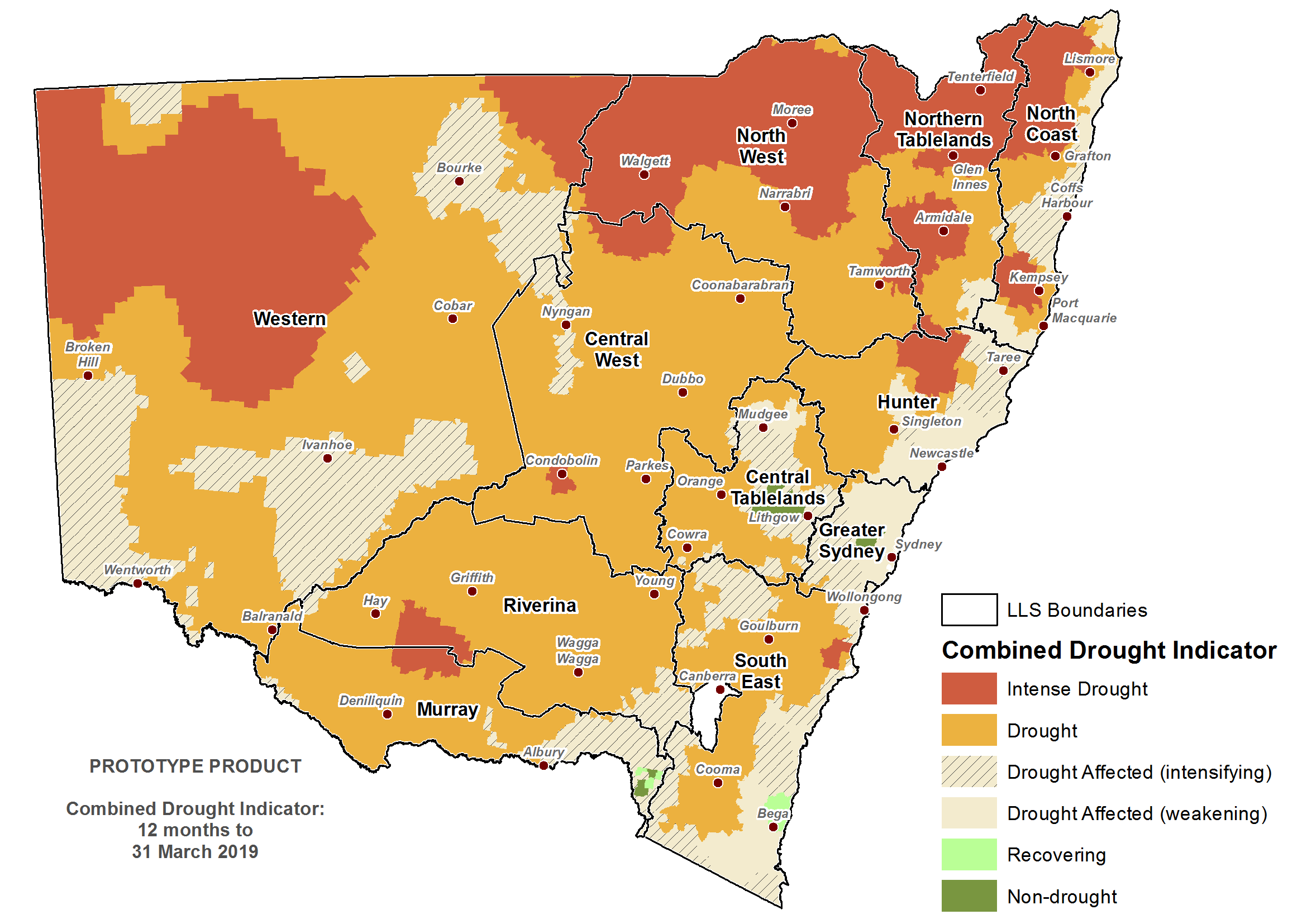
It is important to recognise the CDI provides an aggregated view of the State, and that on-ground conditions can be different to those displayed in the maps. They provide an ‘on average’ view of a particular region only. To report local conditions use DPI Farm Tracker.
Rainfall
Rainfall amounts were generally higher in the eastern half of NSW and lower in the western parts of the state (Figure 2). A small area south of Broken Hill was the exception in the west. A large majority of the higher totals received in the east (between100-200mm) occurred late in the month and included the Hunter Local Land Service (LLS) region extending inland to include the north east of the Central West, the far northern part of the Central Tablelands and southern area of North West LLS regions. Rainfall anomalies for these regions, as well as the Sydney Basin, southern alpine and the southeast corner of the state ranged between 25-100mm above the median for March. Despite the North Coast region receiving falls of rain between 50-200mm, the rainfall anomalies for this region remained below average. Rainfall for western areas of the state was low, with totals from 0-25mm.
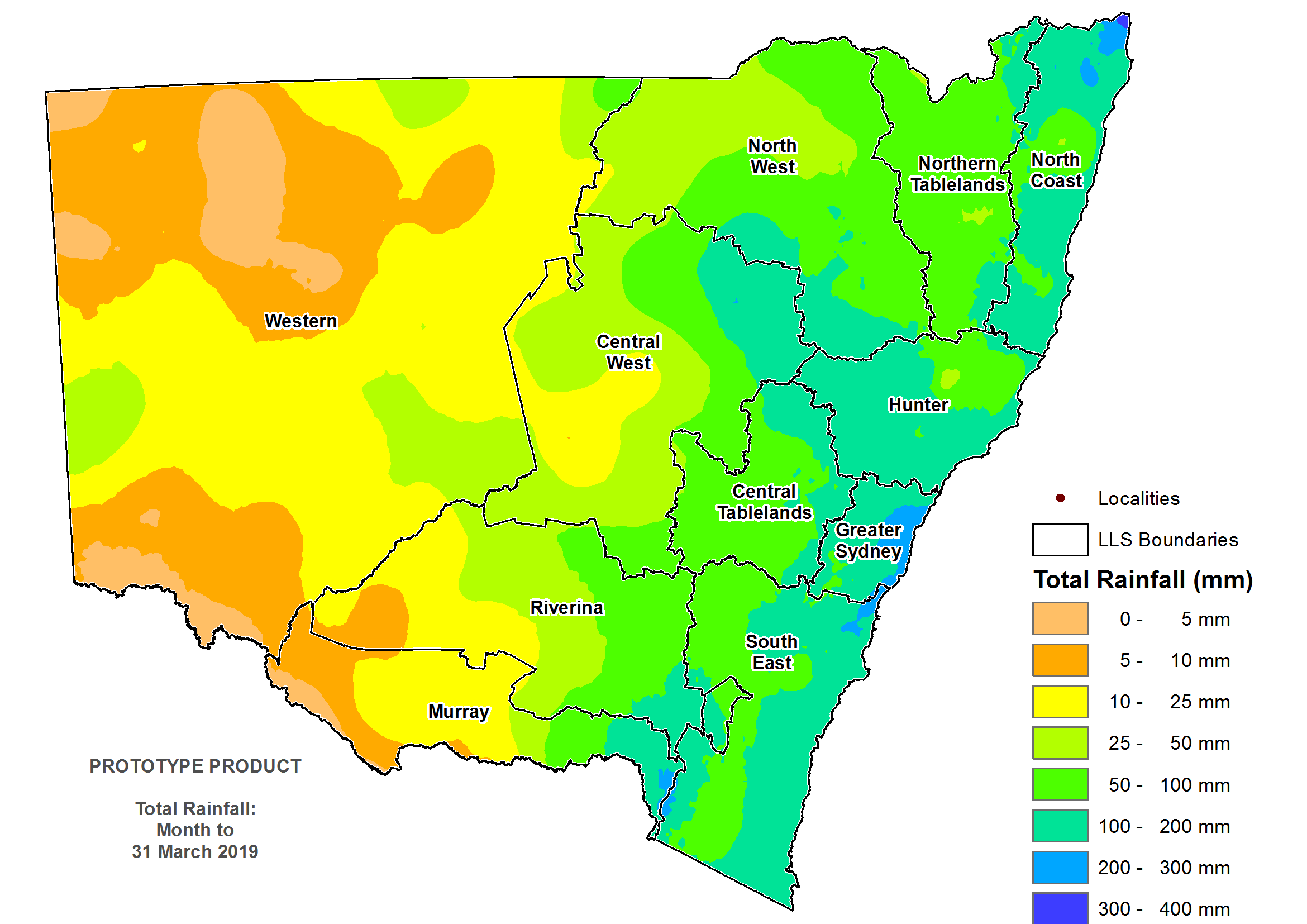
Temperature
Daytime and overnight temperatures were warmer than average across most of the state during March. The Bureau of Meteorology reported that the average temperature was 1.89°C higher than the long term average for the month. Anomalies for daytime temperatures were 0-3°C higher than average and ranged from 27-33°C in coastal regions north of Sydney, the western slopes and southern plains. The northern plains were warmer ranging between 33-36°C, while daytime temperatures in the tablelands, southern coastal and southern alpine regions ranged between 18-27°C .
Overnight temperatures were also warmer with most of the state being 1-3°C above average. Overnight temperatures ranged between 6-12°C in the Central Tablelands, southern highlands and southern alpine regions. The northern tablelands, southern slopes and areas along the Victorian border ranged between 12-16°C, while elsewhere temperatures were milder (15-24°C).
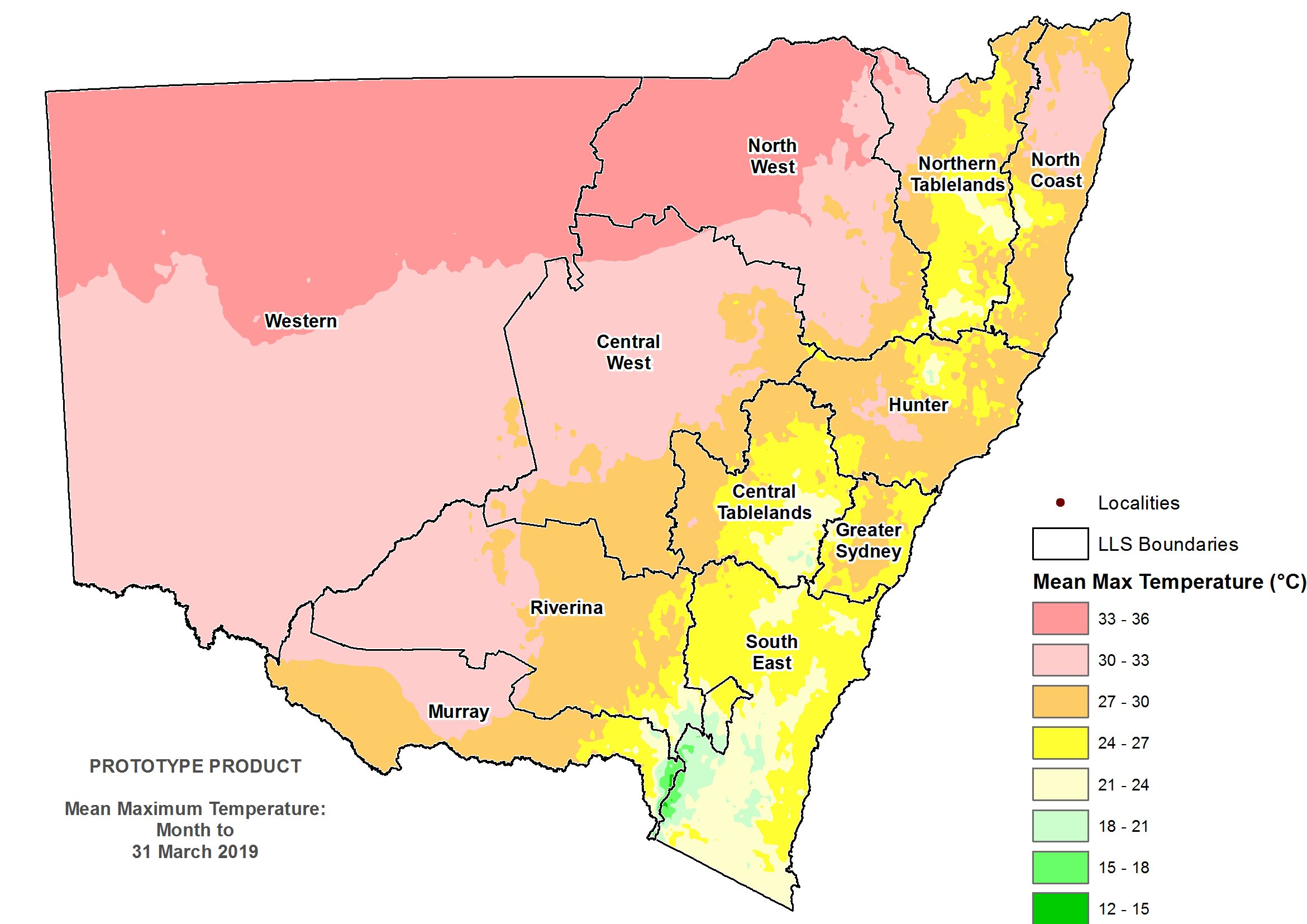
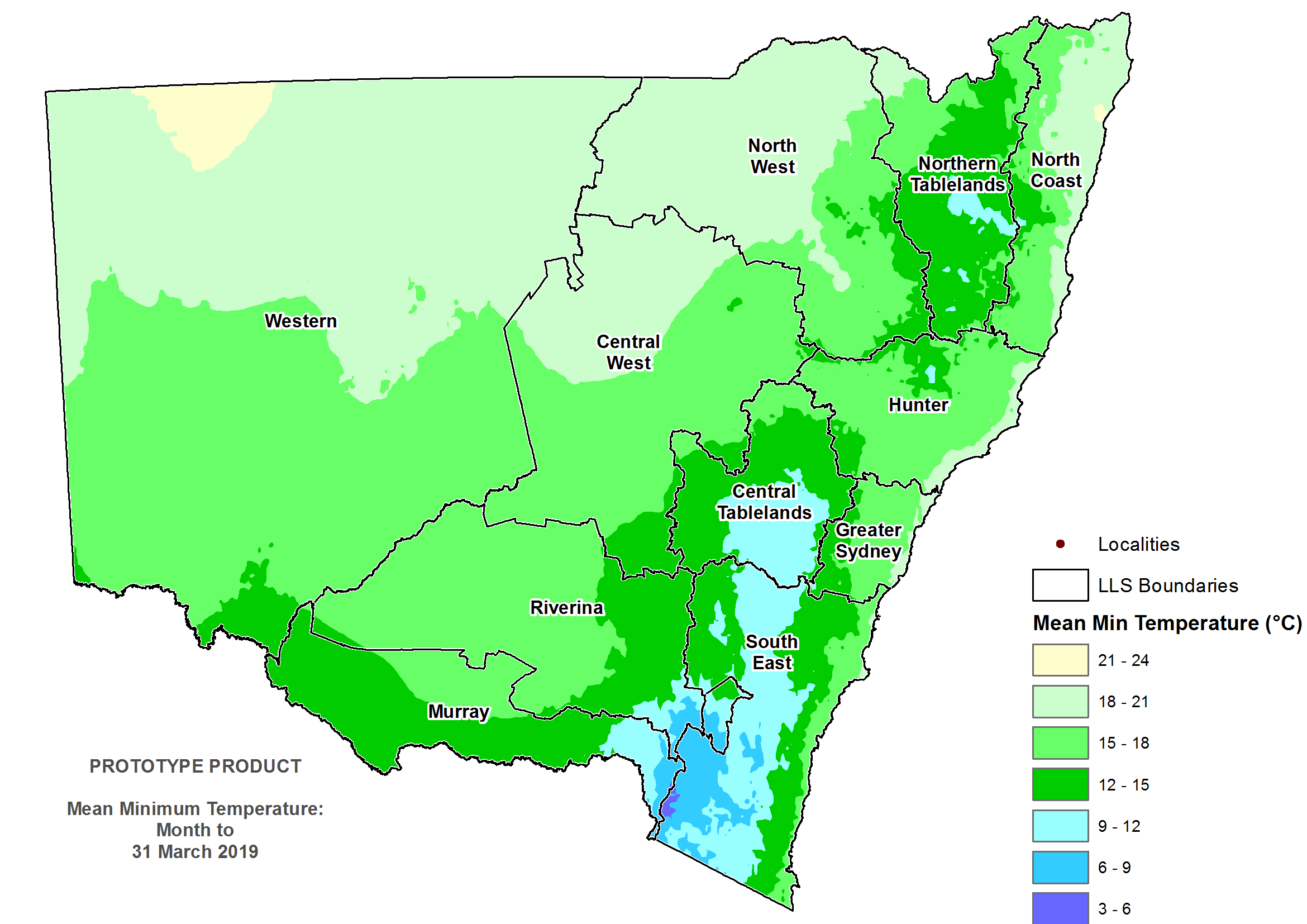
Normalised Difference Vegetation Index (NDVI) Anomaly
The continuation of poor agronomic conditions continues across NSW during March as highlighted by the monthly NDVI anomaly data (Figure 5). These values represent the low levels of plant condition for crops and pastures relative to the long term expectations at this time of year. The central and southern tablelands regions that were exhibiting higher levels of plant activity last month have dissipated as result of inadequate follow-on rainfall and high temperatures during the first half of March. Any significant change in NDVI values as confirmation of an agronomic response to rainfall received in March is expected to take a few weeks.
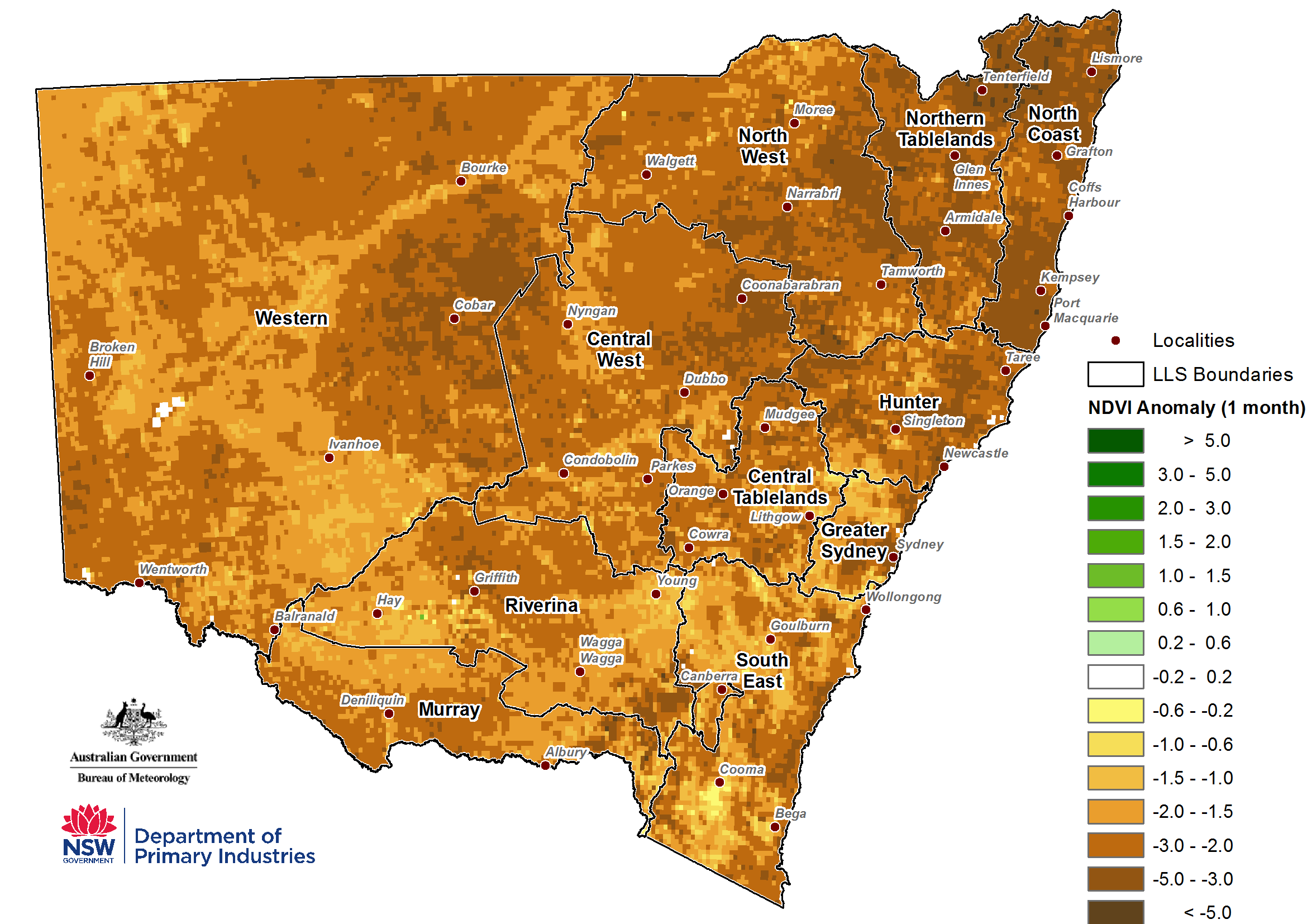
Farm Dam Water Status
Critically low dam levels continue to persist across most of NSW as of 20 March 2019 (Figure 6). There has been some improvement in dam levels through the Central Tablelands, Murray, South East, Hunter, North Coast and Greater Sydney Local Land Services (LLS) Regions, reflecting the pattern of rainfall events during late February and early-to-mid March. The rainfall event towards the end of March will not become available until mid-April. Overall water resources remain critical, particularly for the Western, Central West and North West LLS regions. For further information more details can be found at the Drought Hub.
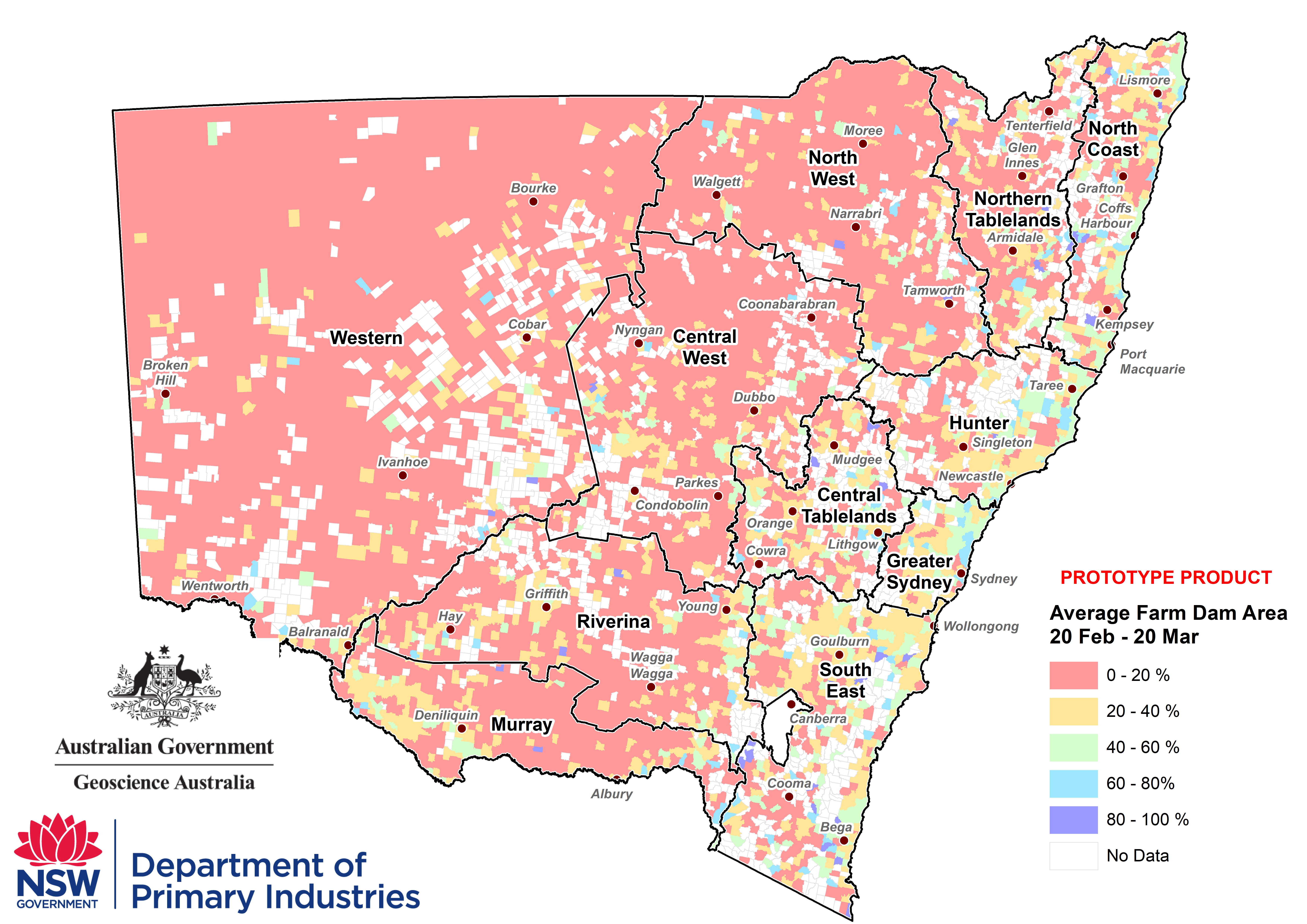
Soil Water Index
An extremely low Soil Water Index (SWI, Figure 7) remains widespread across the state. There has been little change since the February SSU report.
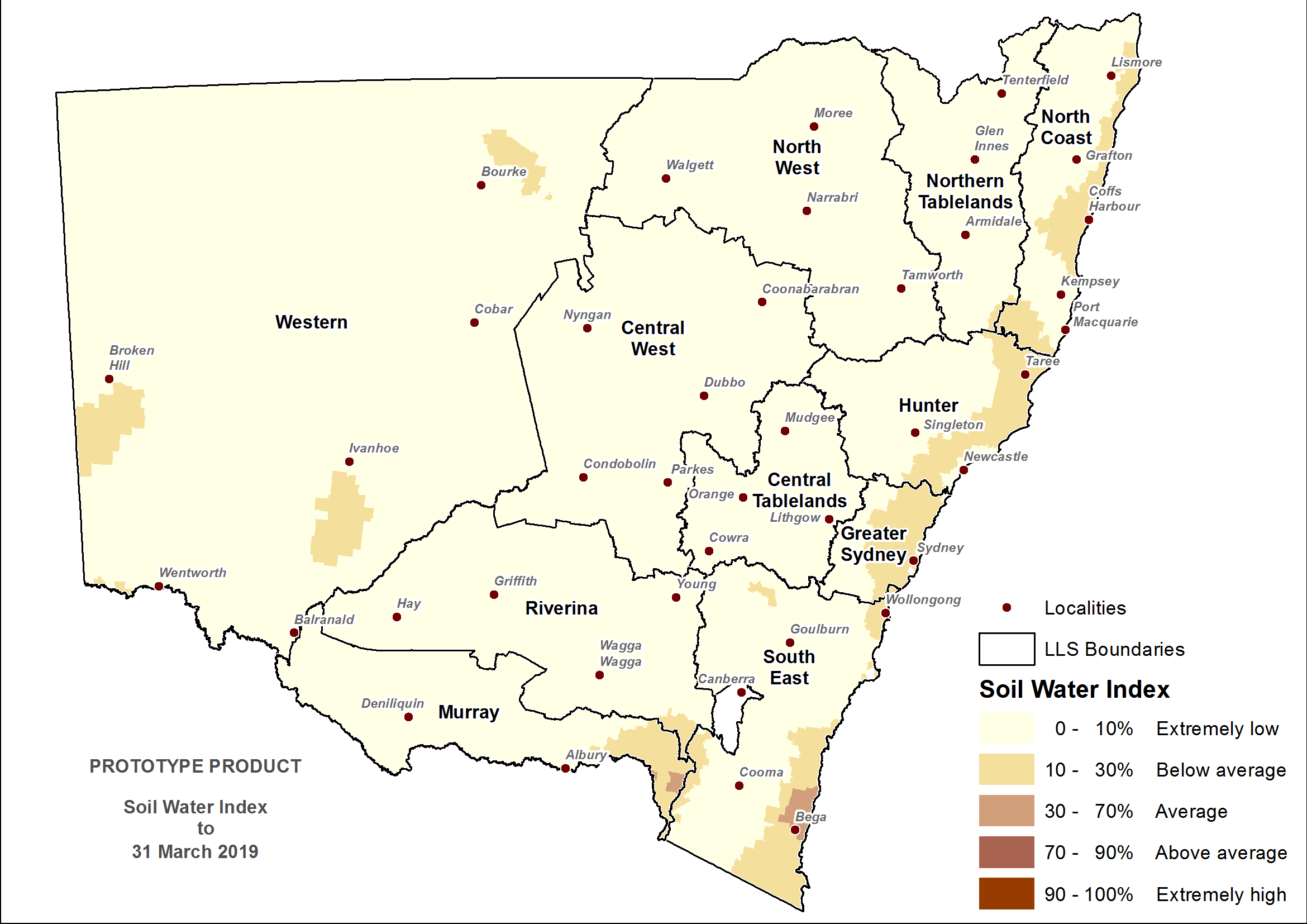
Plant Growth Index
The Plant Growth Index (PGI; Figure 8) remains extremely low across the majority of NSW. This is reflected in the low primary production and poor agronomic conditions the state. The plant growth response to the late March rainfall will not be captured until after the release of this report.
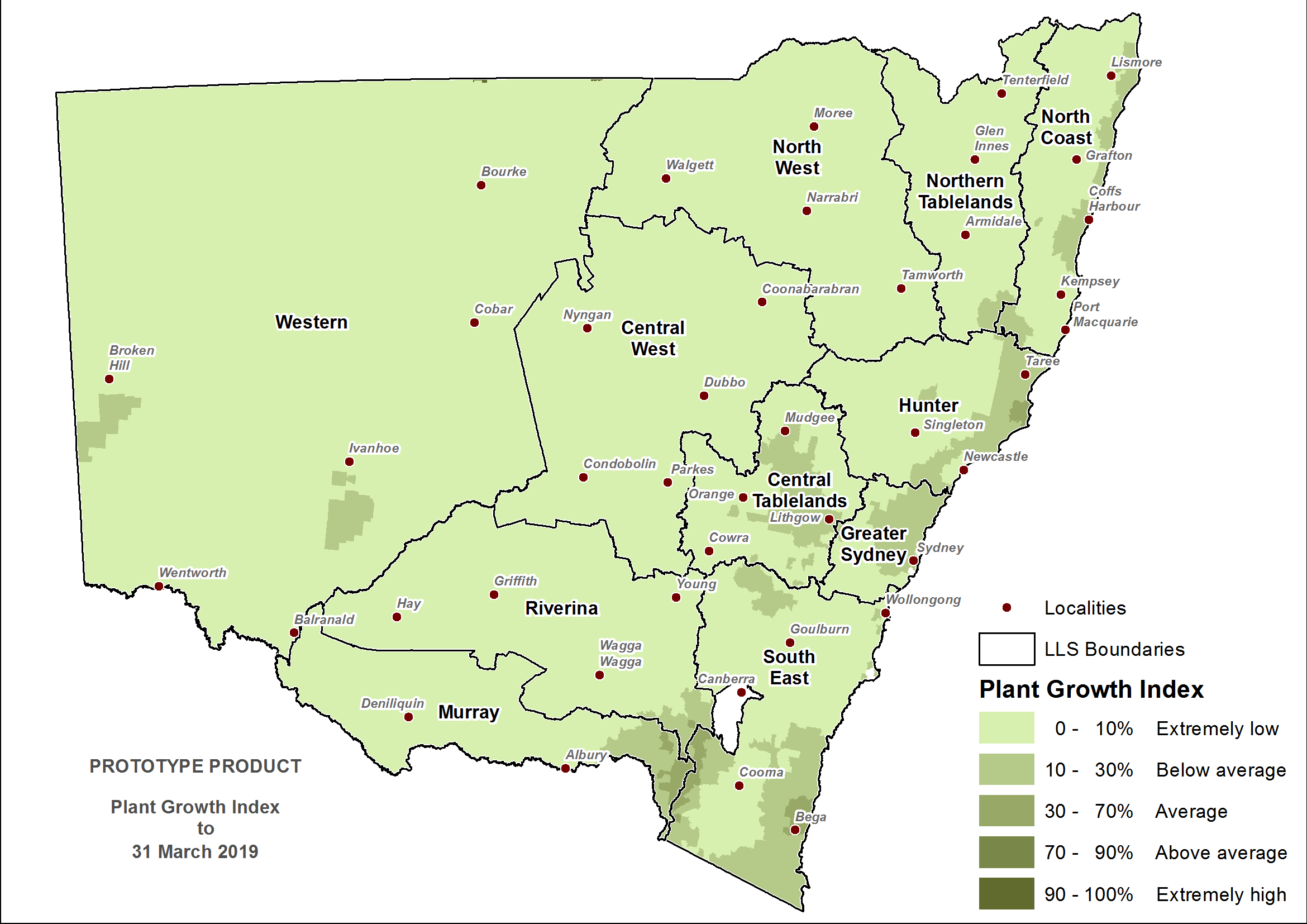
Rainfall Index
Rainfall during the second half of March contributed to an improvement in the Rainfall Index (RI, Figure 9) in some areas of the state. In general the RI remains below average to extremely low, although average levels have been recorded in the Central Tablelands, Greater Sydney, South East, Murray and North Coast Local land Services regions. Despite some improvements, and as noted above for the SWI and PGI, there has been little agronomic benefit to date. Should conditions allow, any agronomic benefits from the rainfall received very late in March are likely to become evident in early April.
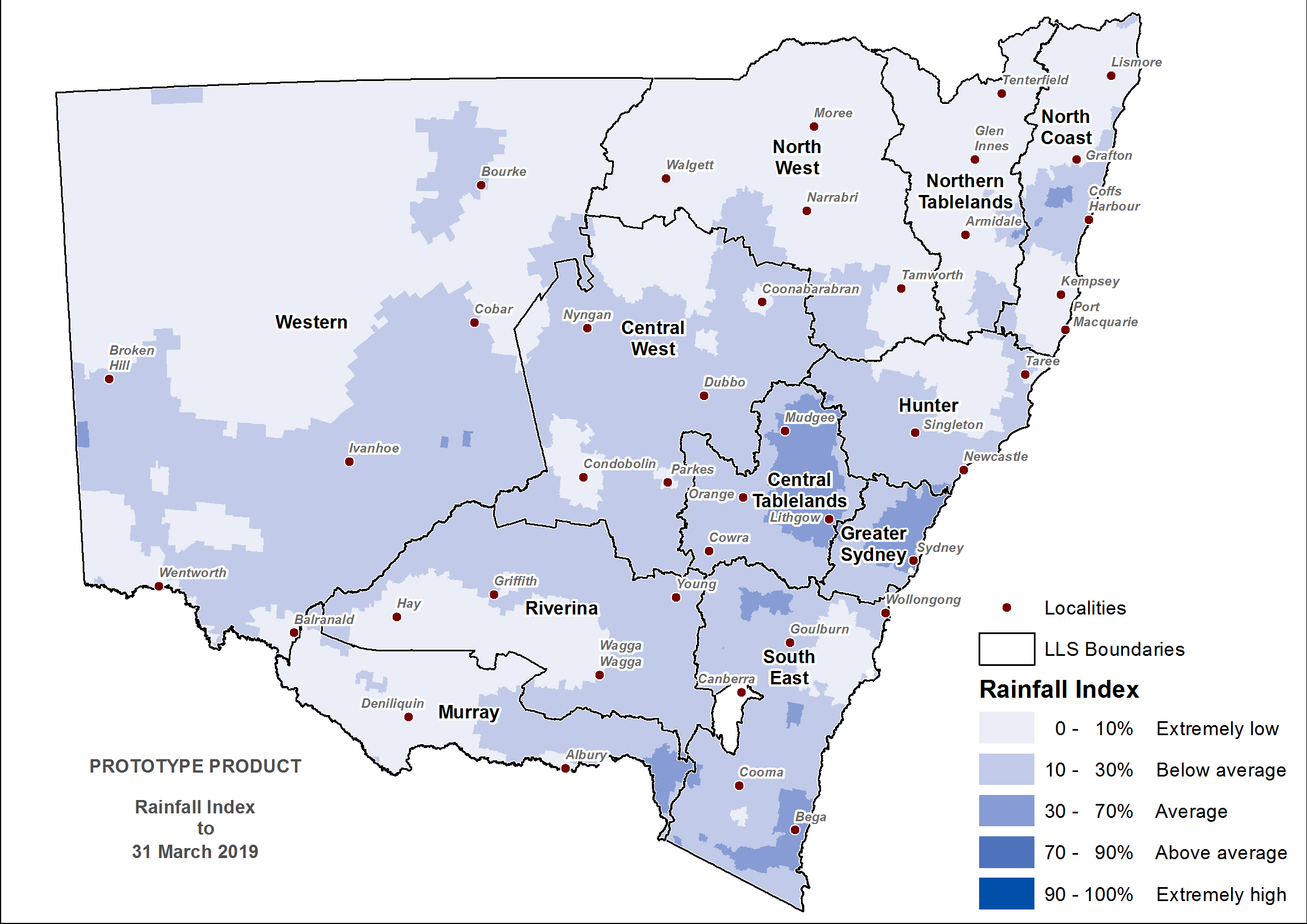
Drought Direction Index
There is still a large proportion of NSW experiencing a drier trend as of 31 March 2019. The Drought Direction Index (DDI, Figure 10) shows the impact of the March rainfall contributing to a wetter trend in parts of eastern NSW.
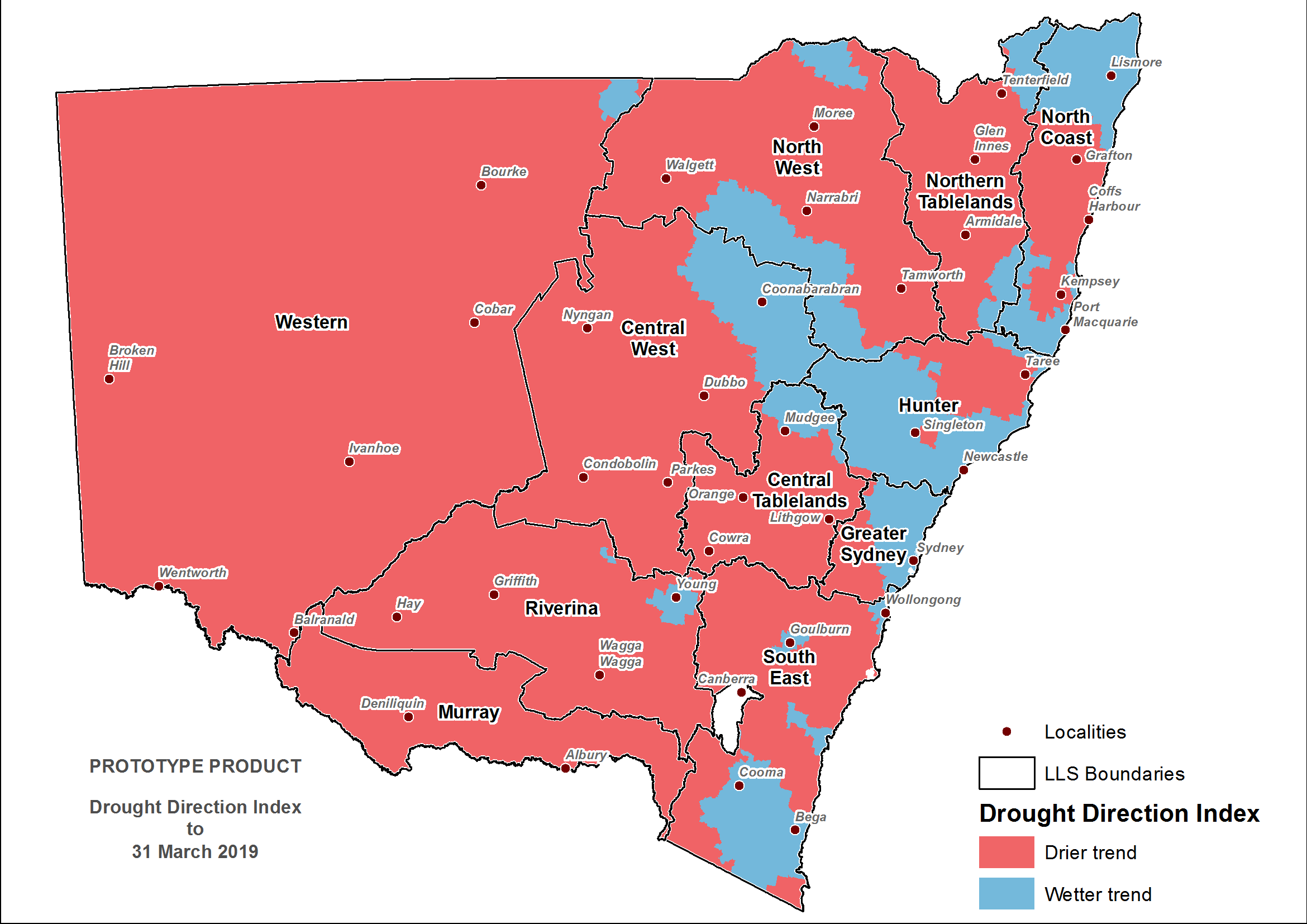
Changes in the individual drought indicators may have occurred since this update was released. For the most current information, please visit Drought Hub.
CDI status for the regions
Figure 11 displays the CDI status for each individual Local Land Services region to 31 March 2019.
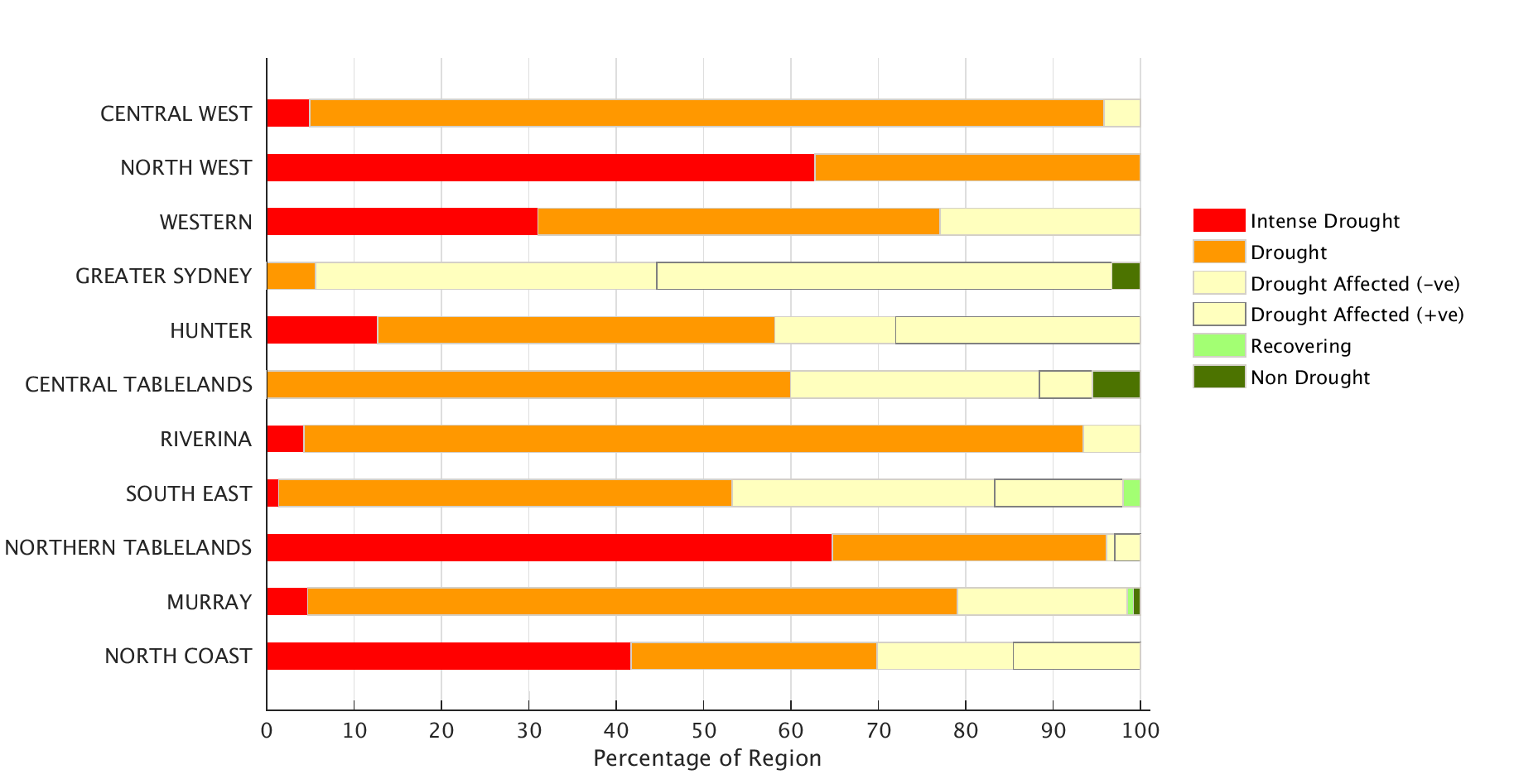
Murray and Riverina regions
The Murray and Riverina Local Land Services (LLS) regions continue to experience drought conditions. The Combined Drought Indicator (CDI) shows that the majority of the region remains in either the Drought Affected, Drought or Intense Drought categories (Figure 12). The area in the Intense Drought category has retracted since the February State Seasonal Update, and now centers around the area to the west of Coleambally. Despite this, on-ground conditions have not improved for the majority of these regions. The small area in the far southeast of the Murray LLS region continues to show signs of recovery following some more consistent rainfall events.
Despite these LLS regions experiencing some rainfall events during the past month, there has been no significant improvement to the Soil Water Index (SWI). Further rainfall is required to replenish the long-term soil moisture deficits occurring in these regions.
The monthly NDVI anomaly data (Figure 13) indicates that the entire region continues to be experiencing below normal levels of greenness. Any significant changes in the NDVI anomaly values in response to the rainfall received in late March is expected to take a few weeks.
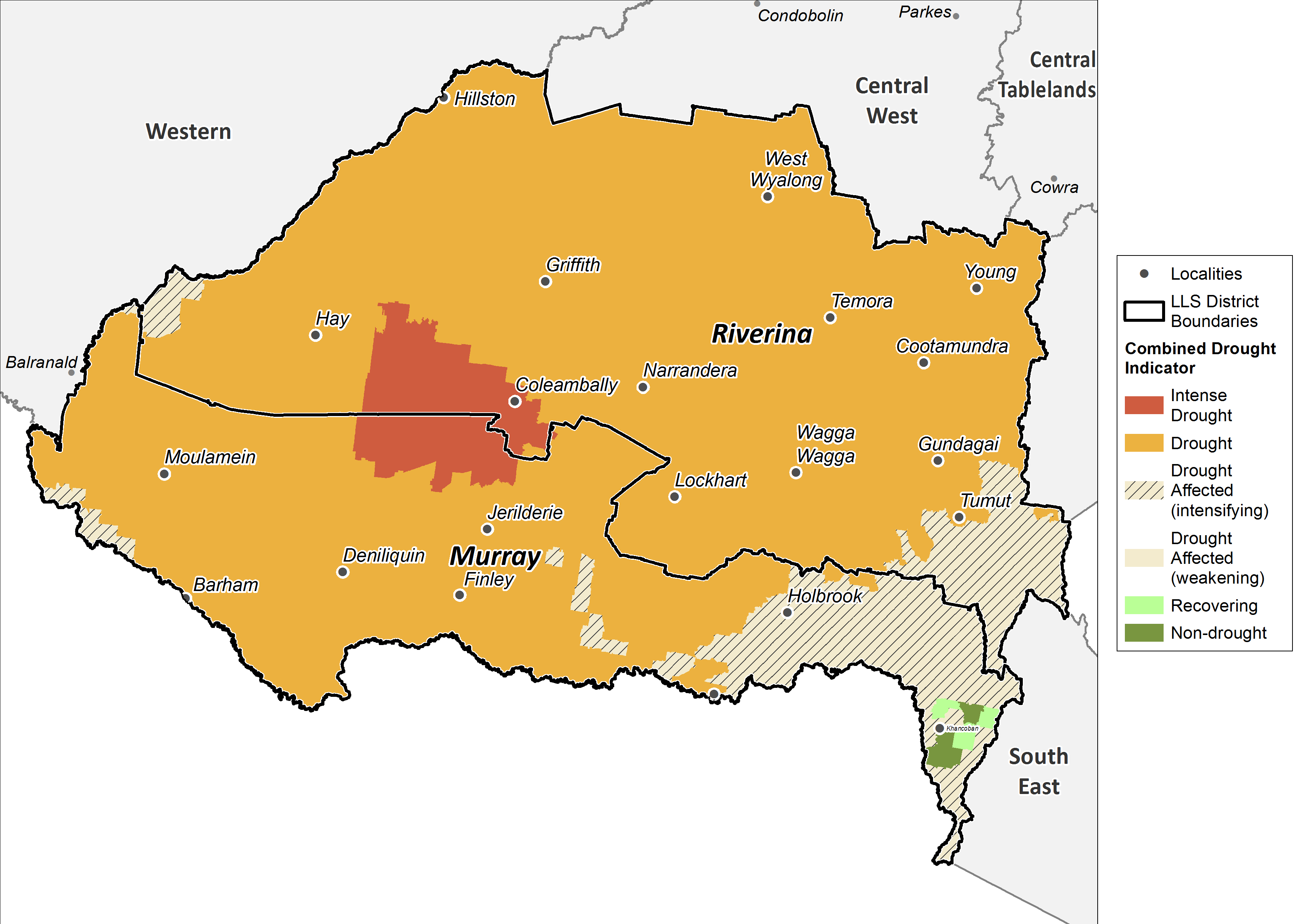
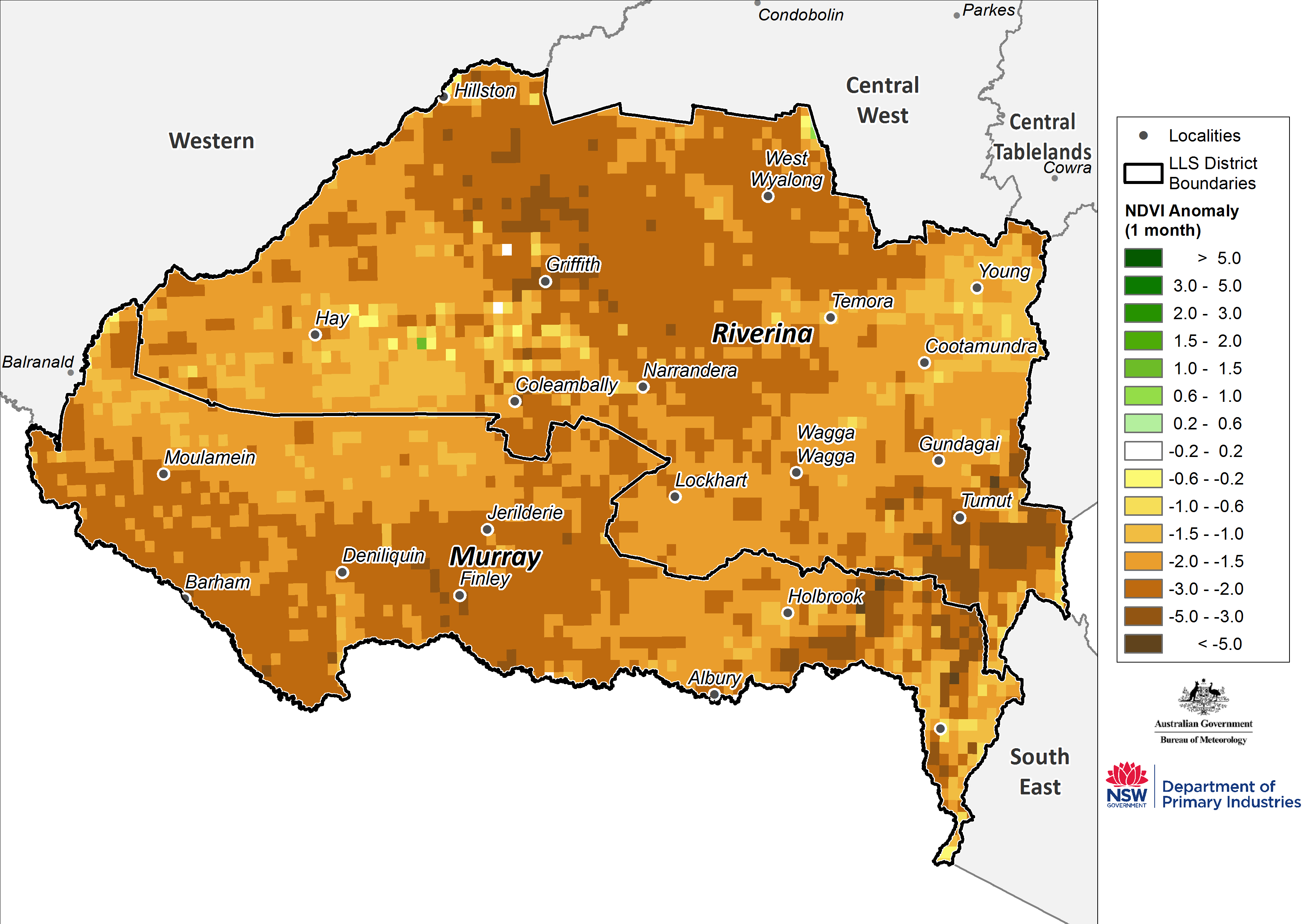
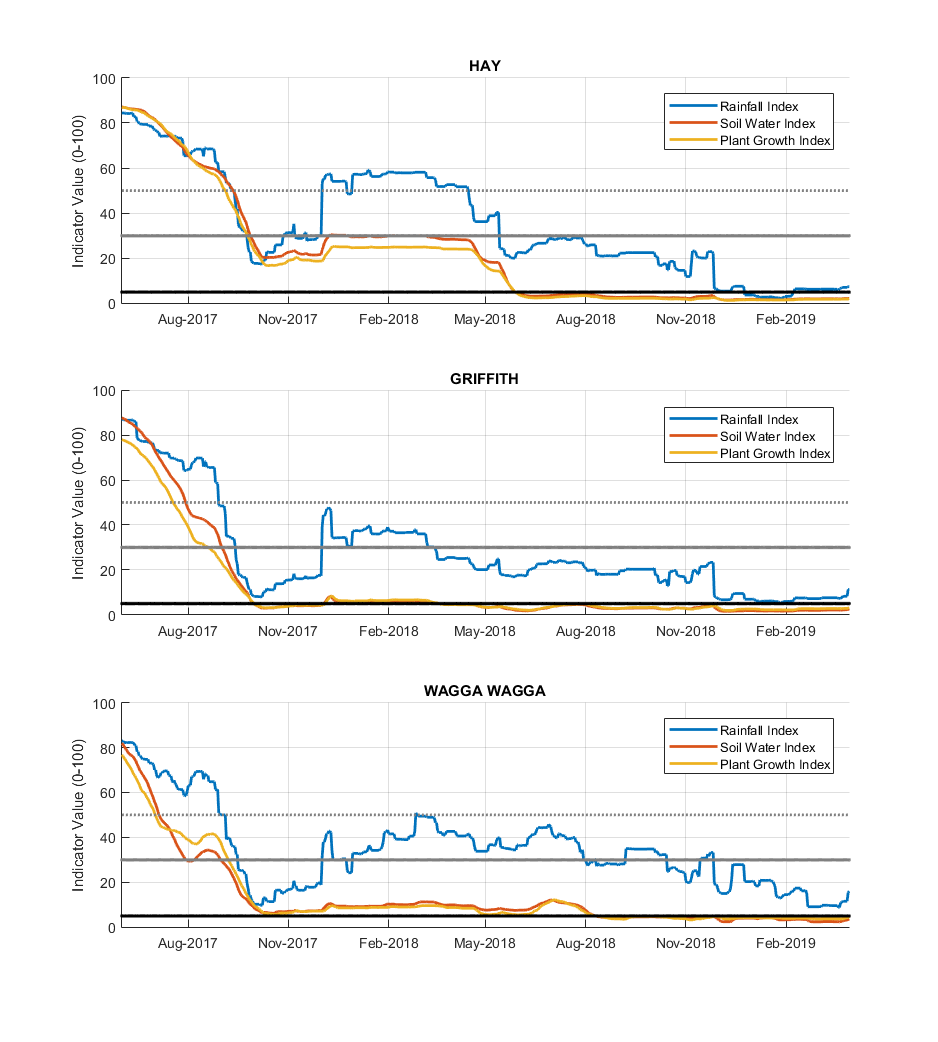
Western region
The Western Local land Services (LLS) region continues to experience drought conditions, with the entire area being in one of the three drought categories of Drought Affected, Drought or Intense Drought (Figure 15). The Combined Drought Indicator (CDI) shows that the area in Intense Drought remains relatively stable since the February State Seasonal Update, except for an area to the north of Wanaaring, which has transitioned into the Drought category since the last update. Rainfall throughout March was not conducive to improving on-ground conditions for the majority of the region.
The monthly NDVI anomaly data (Figure 13) indicates that the entire regions continues to be experiencing below normal levels of grenness. Minimal grass cover across large parts of the region continue to be of concern, with environmental risks such as dust storms and erosion losses remaining at extremely high levels.
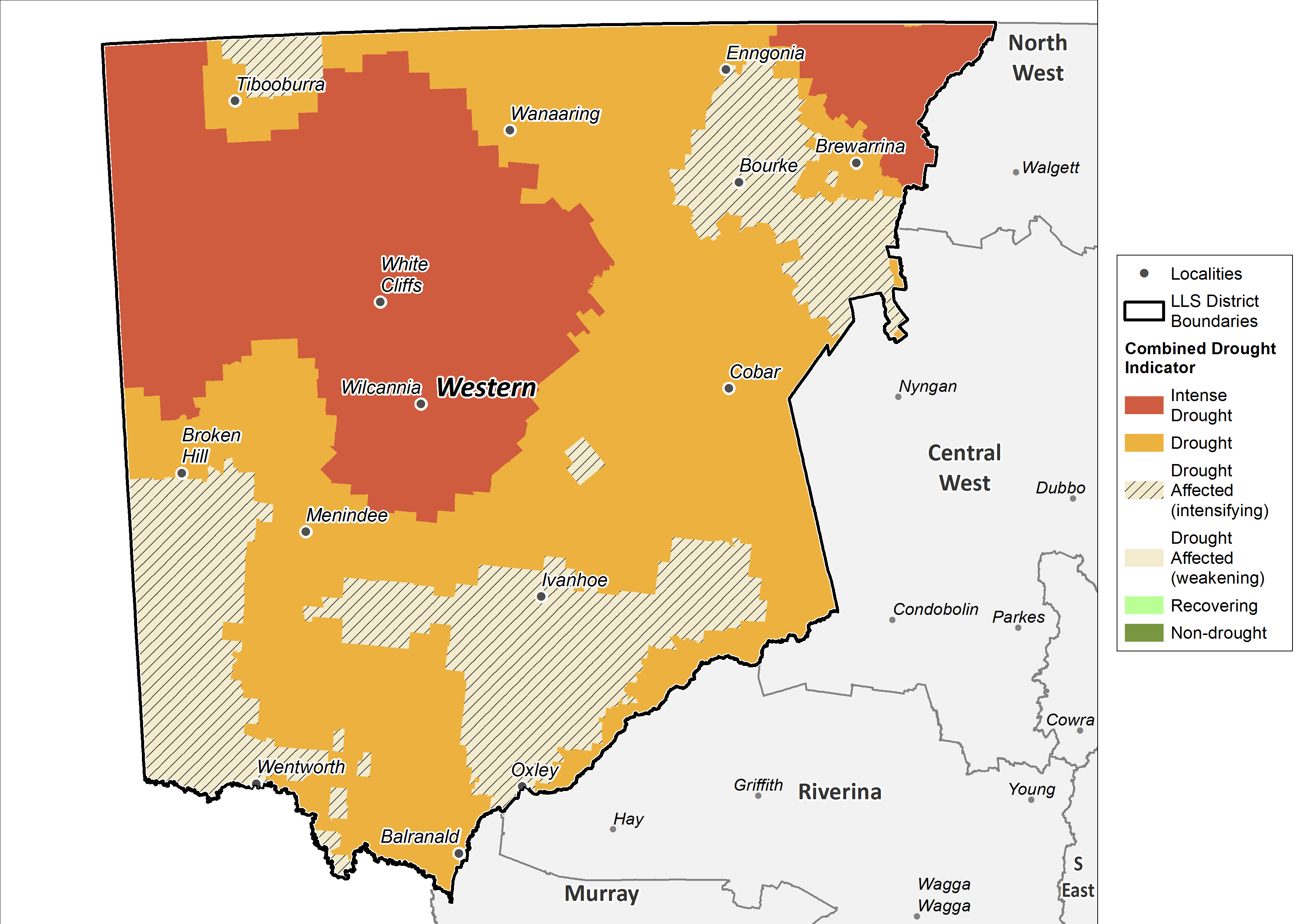
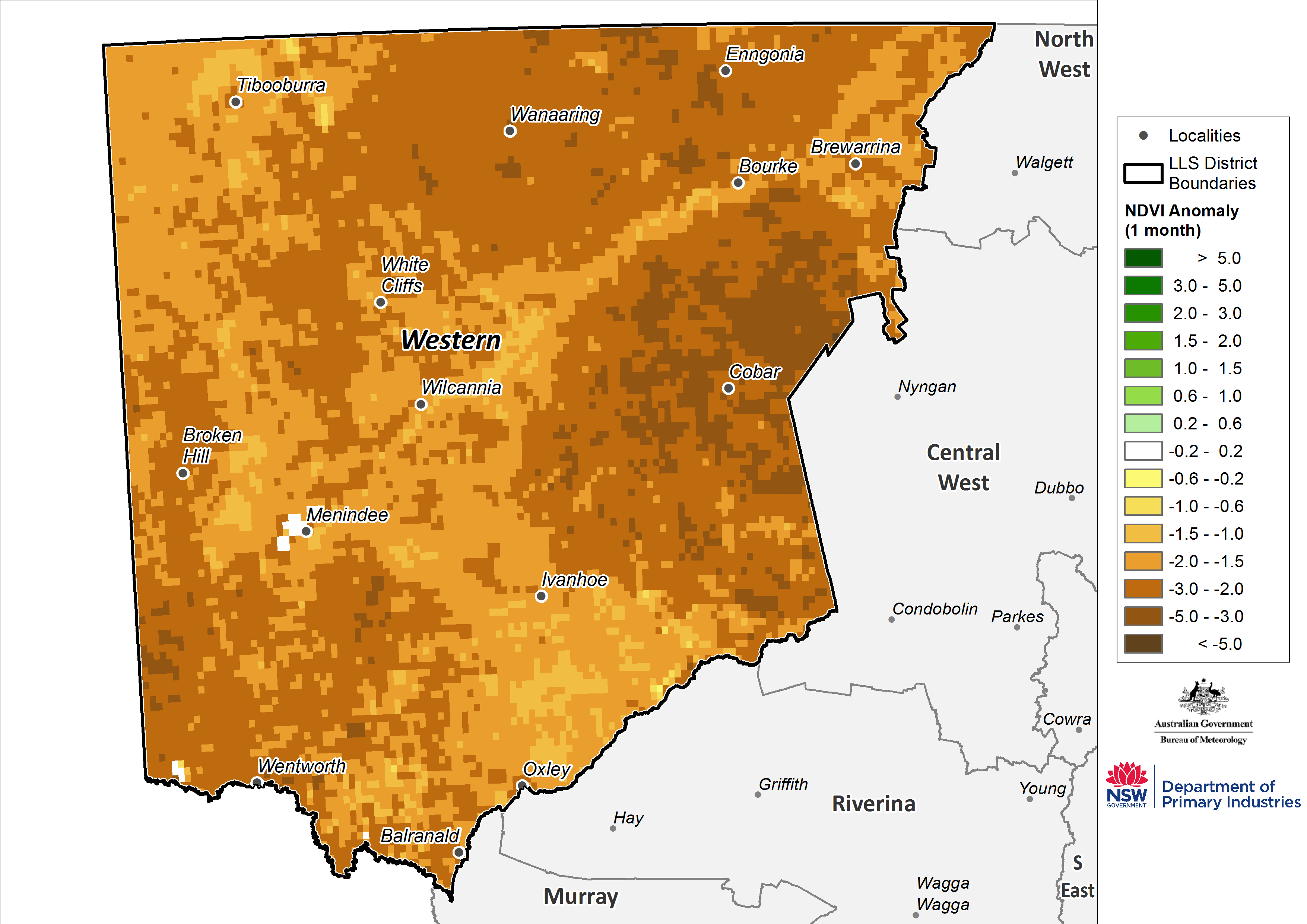
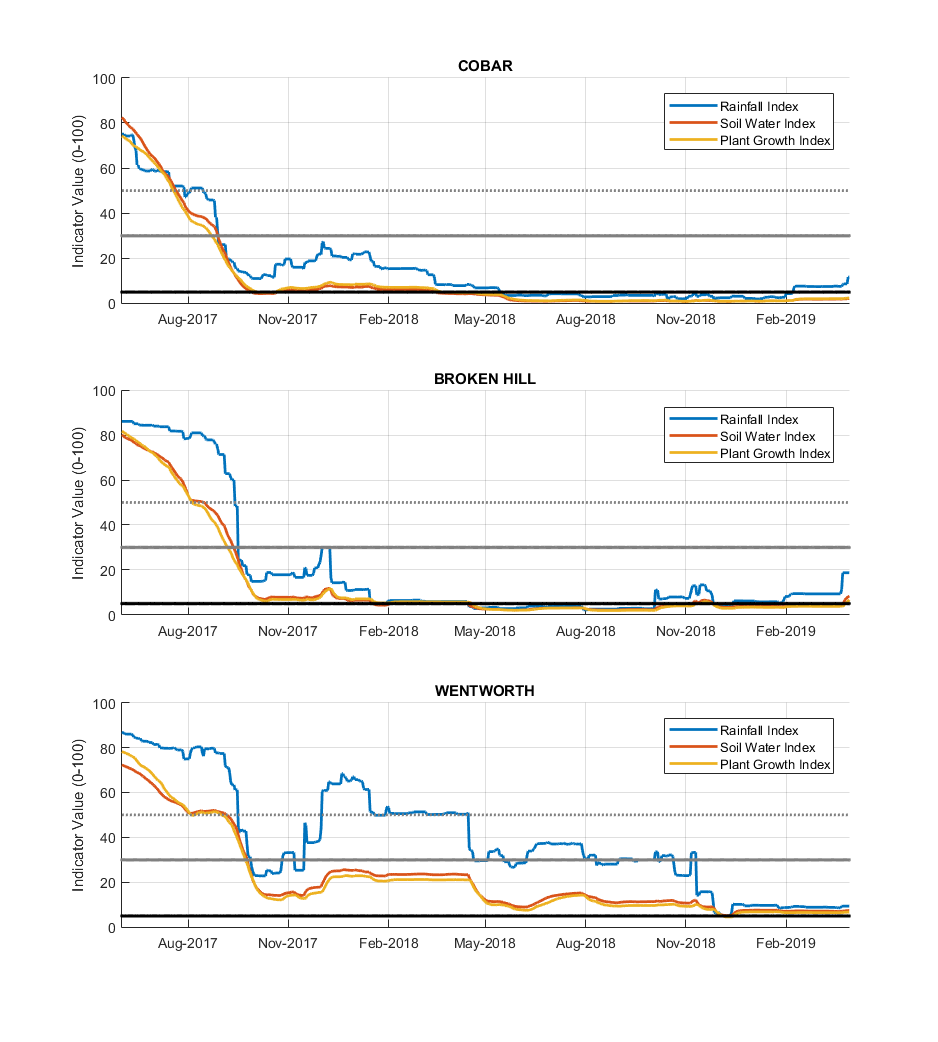
North West, Northern Tablelands and North Coast regions
Information from the Combined Drought indicator (CDI; Figure 18) shows that the entire region continues to experience drought conditions and is classified in either the Drought Affected, Drought or Intense Drought categories. The area classified in Intense Drought has generally retracted since the February State Seasonal Update and is mainly the result of some higher rainfall totals occurring late in March. Despite this, there are large areas across these regions indicated as remaining in the Intense Drought category and in some instances conditions have continued to decline, with the area west of Kempsey being an example. Any sustained on-ground improvements resulting from the March rainfall is yet to be confirmed due to it occurring at the very end of the month. In general, conditions remain very poor in northern and western areas across these regions where rainfall totals were less.
Despite the recent rainfall events, especially in the eastern areas, the Soil Water Index at the end of March suggests that continued and consistent rainfall will be necessary to replenish the long-term soil moisture deficits. Western areas remain particularly dry after March rainfall totals were lower in comparison to some of the eastern areas.
The monthly NDVI anomaly data (Figure 19) indicates that the entire region continues to be experiencing below normal levels of greenness. Any significant changes in the NDVI anomaly values in response to rainfall received in late March is expected to take a few weeks.
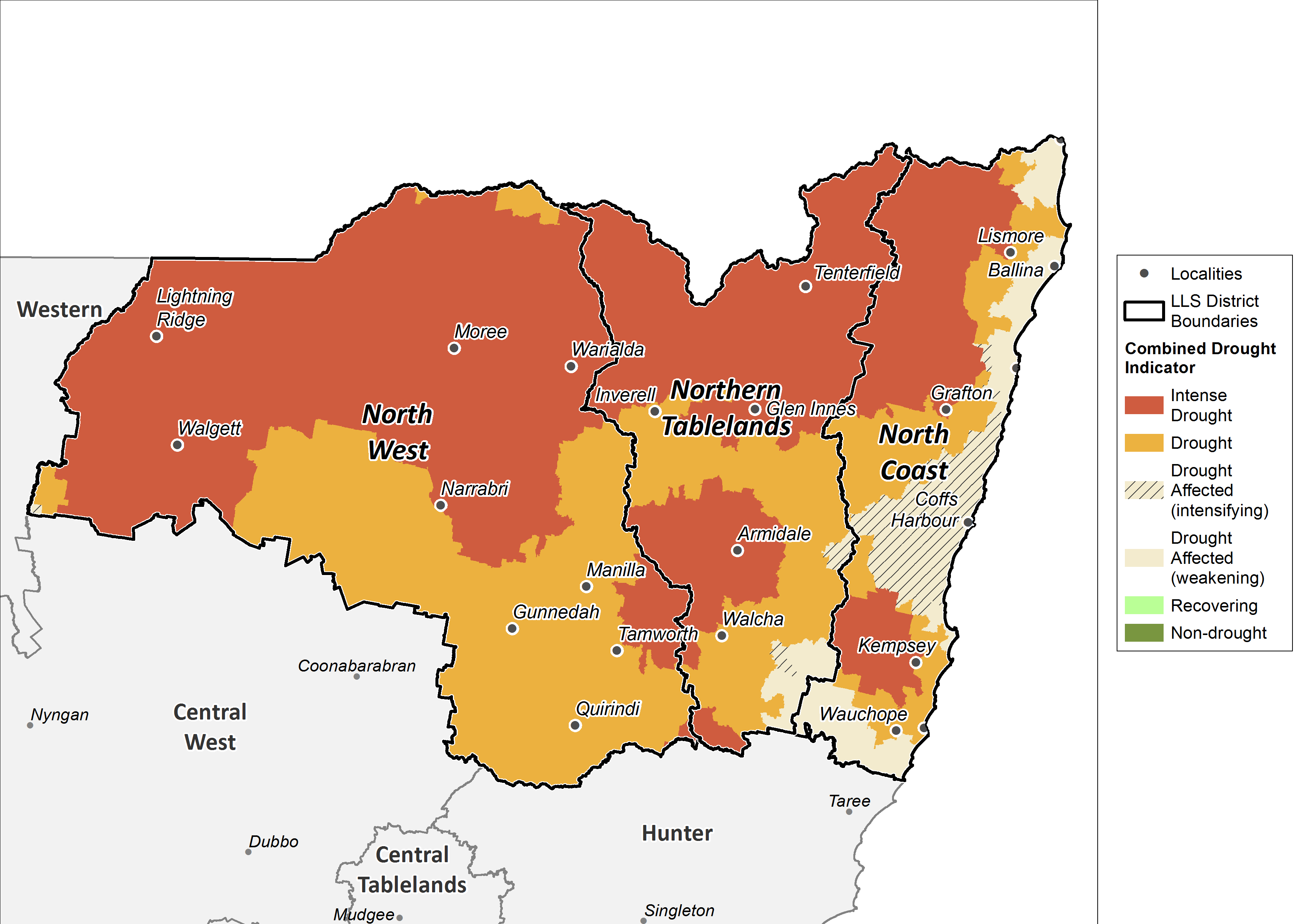
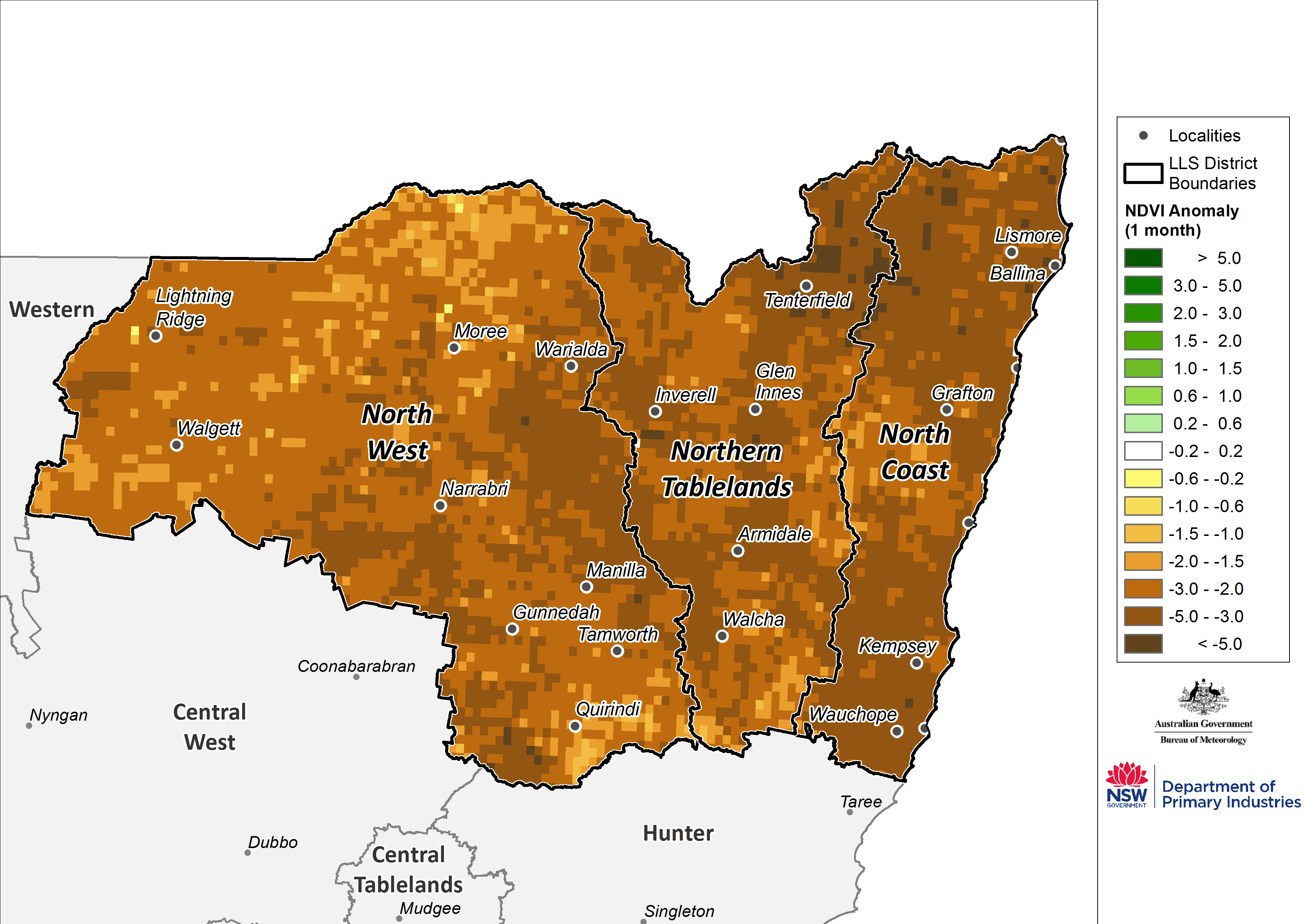
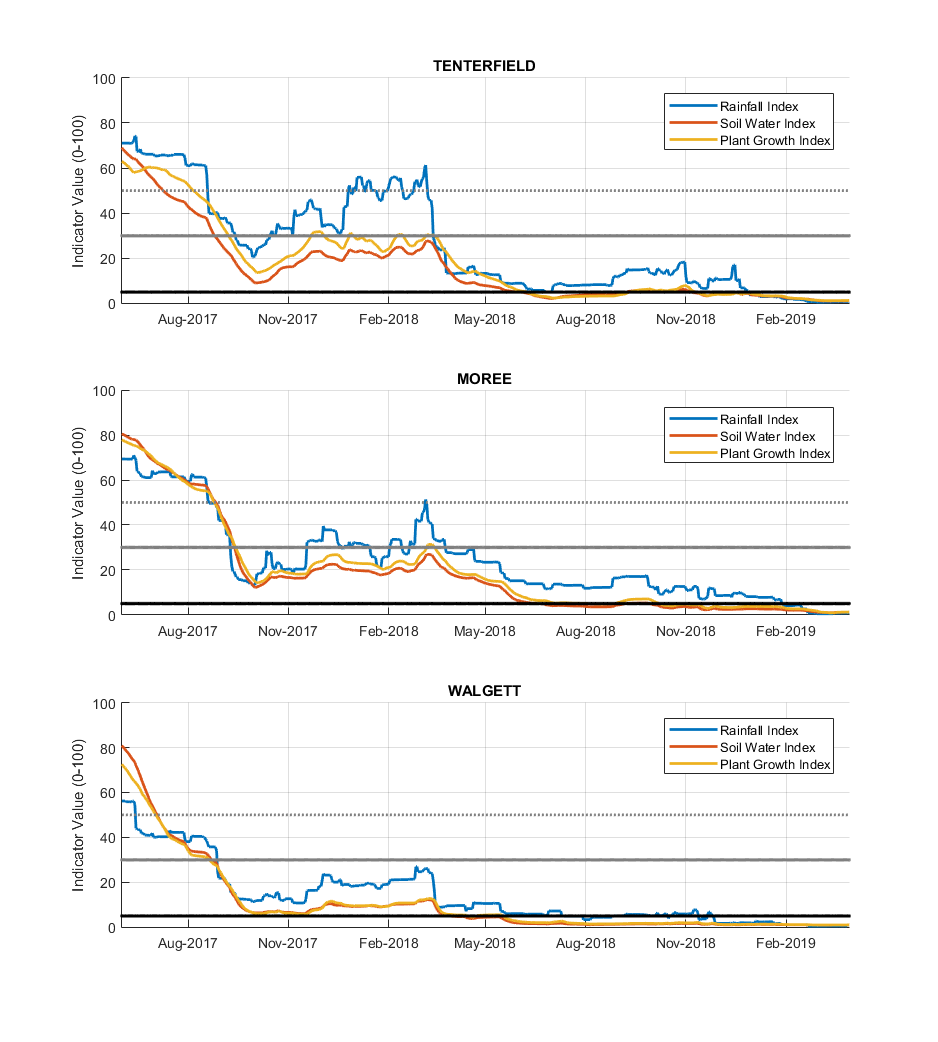
Central Tablelands, Central West, Hunter and Greater Sydney regions
Conditions across the Central Tablelands, Central West, Hunter and Greater Sydney Local Land Services regions (LLS) have slightly improved since the February State Seasonal Update. The Combined Drought Indicator (Figure 21) suggests that the area in the Intense Drought category has retracted in many parts and is only occurring to the north-west of Coonamble, to the west of Gloucester and around Condobolin. There are also signs of improvements in the area classified as Drought Affected, with large areas in the Greater Sydney and Hunter LLS regions currently being classified as Drought Affected (Weakening). Any sustained on-ground improvements resulting from the March rainfall is yet to be confirmed due to it occurring at the very end of the month.
Despite the recent rainfall events, especially in the eastern areas, the Soil Water Index at the end of March suggests that continued and consistent rainfall will be necessary to replenish the long-term soil moisture deficits. Western areas remain particularly dry after March rainfall totals were lower in comparison to some of the eastern areas.
The monthly NDVI anomaly data (Figure 22) indicates that the entire region continues to be experiencing below normal levels of greenness. Any significant changes in the NDVI anomaly values in response to rainfall received in late March is expected to take a few weeks.
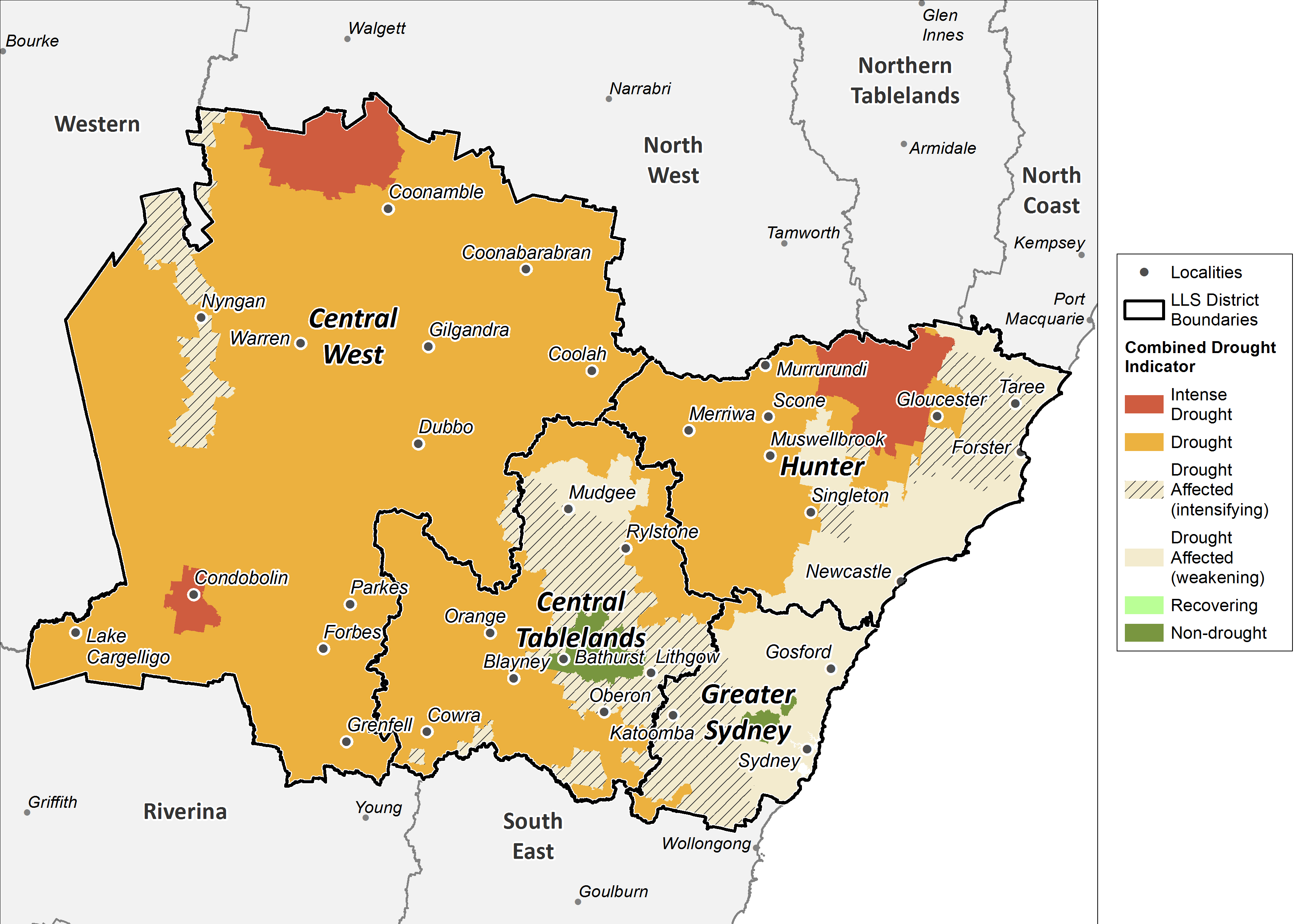
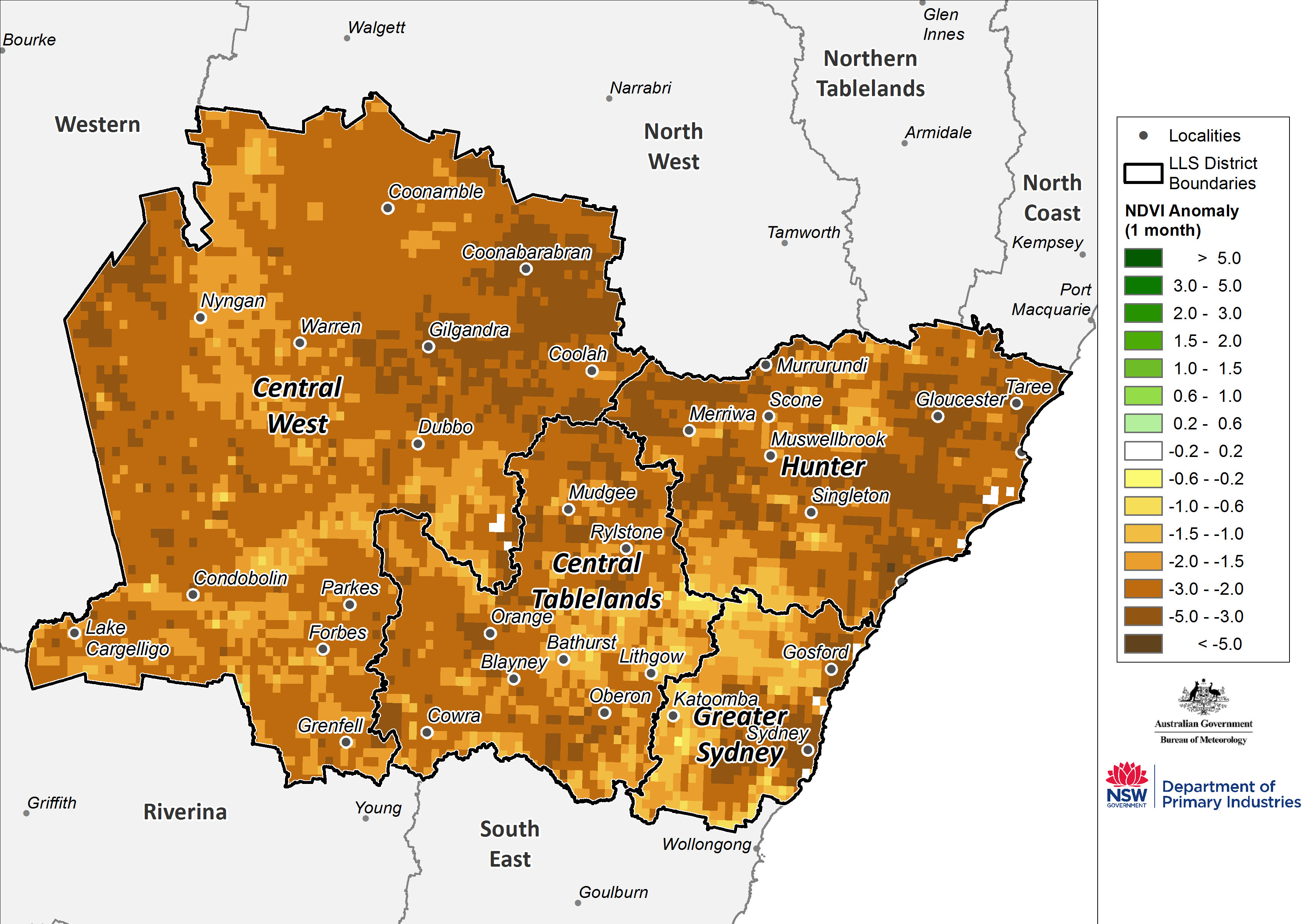
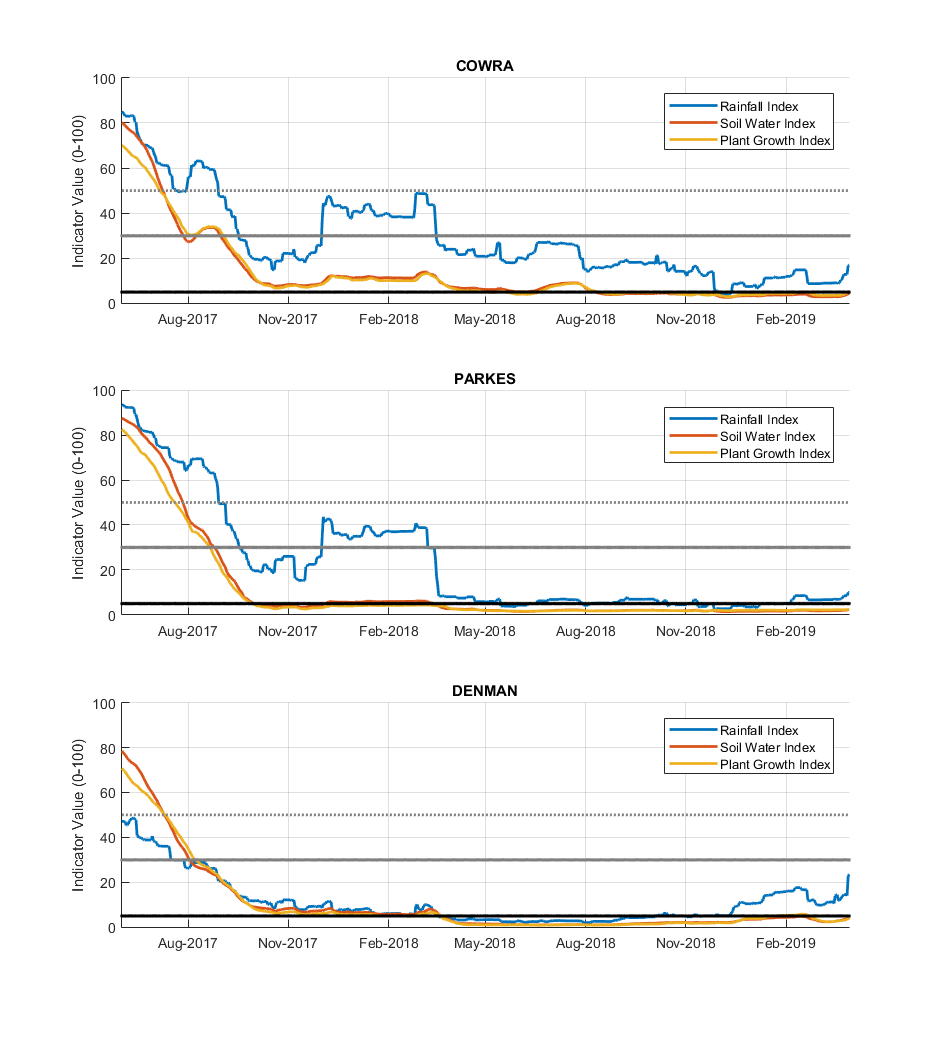
South East region
Conditions across the South East Local Land Services regions (LLS) have slightly improved since the February State Seasonal Update. The Combined Drought Indicator (Figure 21) suggests that the area in the Intense Drought category has retracted and is only in a small area around Nowra. There are also signs of improvements in the area classified as Drought Affected, particularly in the south (including regions around Bega and Bombala).
Some areas within this region may potentially enter a period of short term drought recovery. Additional rainfall will be required on a consistent basis to provide further improvements to soil moisture stores and resultant plant growth on a long-term basis.
The monthly NDVI anomaly data (Figure 25) indicates that the entire region continues to be experiencing below normal levels of greenness for March. Any significant changes in the NDVI anomaly values in response to rainfall received in late March is expected to take a few weeks.
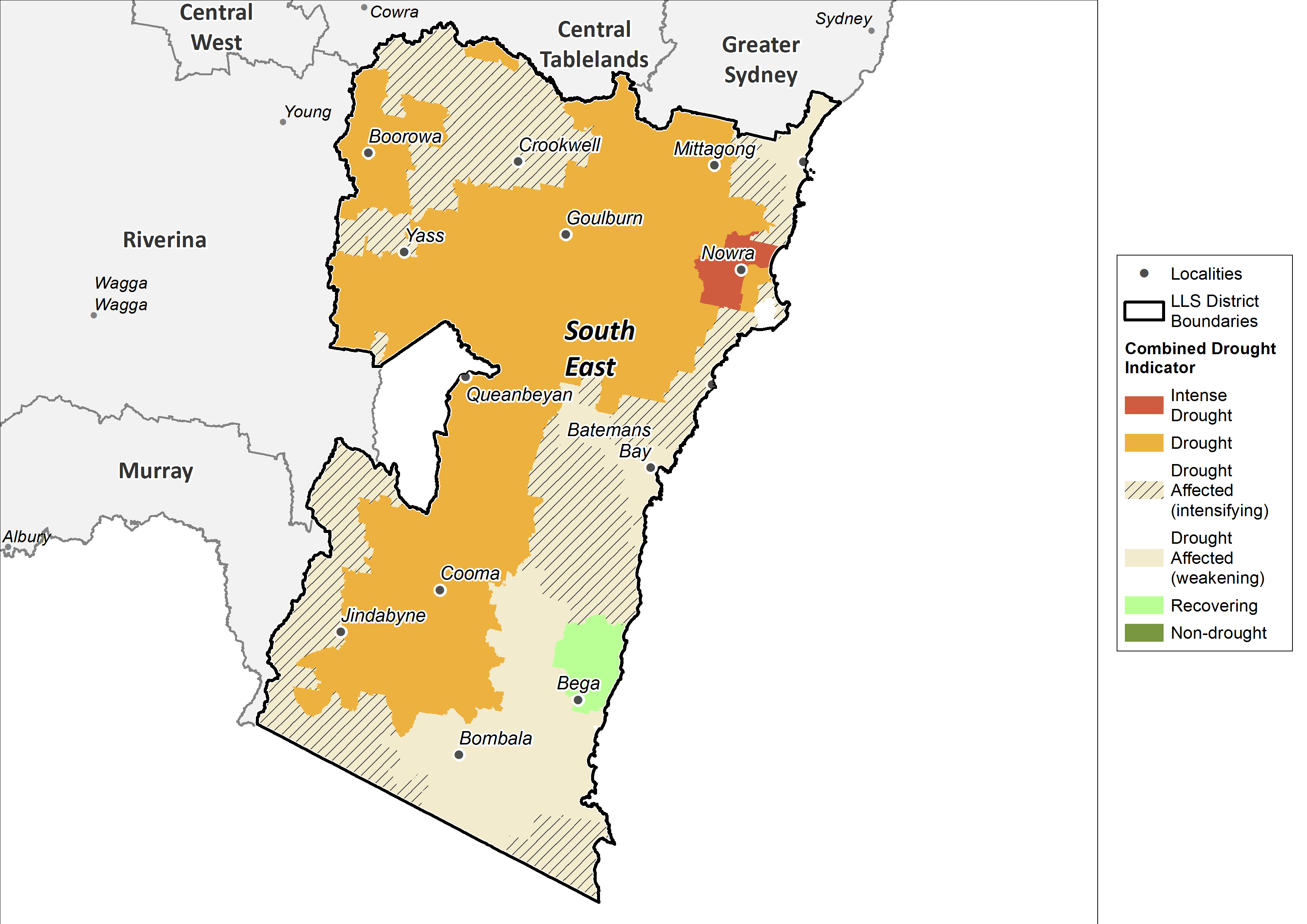
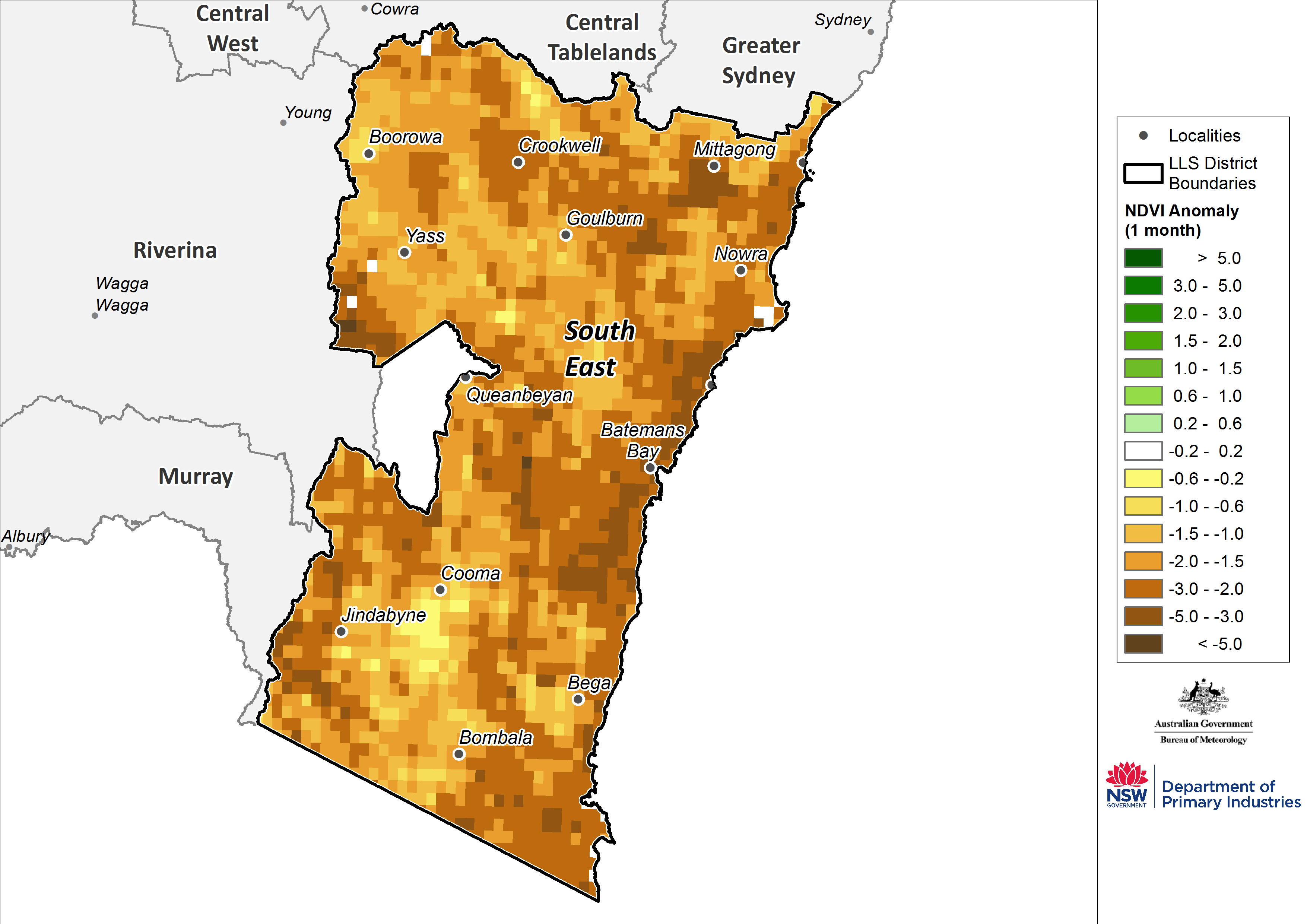
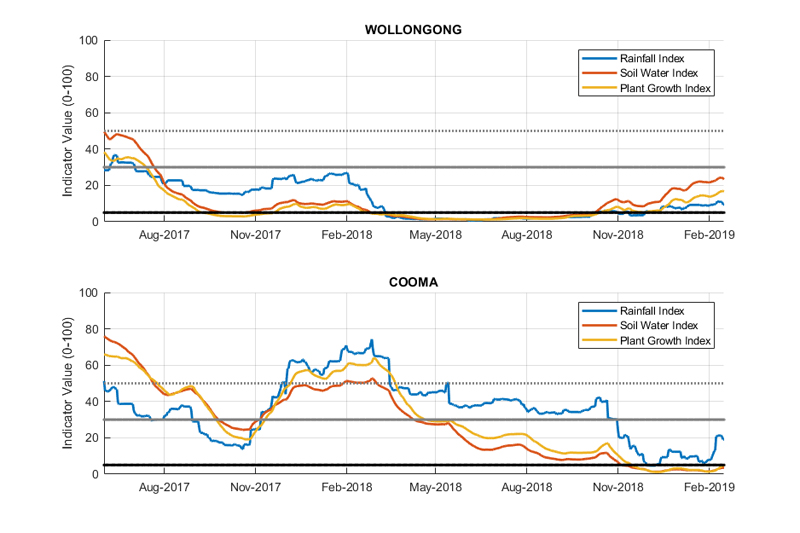
Official national outlook
The official national climate outlook for April to June was released by the Bureau of Meteorology on 28 March 2019. The rainfall outlook for the next three months was neutral with no strong indication either way towards wetter or drier than average conditions across Australia. There is a slightly higher chance of above median rainfall indicated for the central region of Western Australia and the eastern coast of the Gulf of Carpentaria. The skill for the Bureau’s rainfall model indicates a moderate accuracy for this time period for most of the country, however the accuracy is low for the south and southeast of Australia.
The Bureau indicates that day and night time temperatures are likely to remain warmer for April to June for the majority of Australia, with the north and eastern areas of the country showing an increased chance (>70%) of being warmer than average.
NSW outlook
The April to June rainfall outlook shows there is a near equal chance (40-60% probability) of wetter or drier than average conditions across most of NSW over the next three months (Figure 27). A slightly lower probability is currently indicated for the south east corner, southern tablelands and central tablelands of the state, while the Sydney basin, the central coast and the northern part of the south coast regions have a lower chance (30-40%) of receiving median rainfall. The large fluctuations observed in these outlook models over the last six weeks highlights the impact of low to moderate accuracy for forecasting skill levels at this time of year.
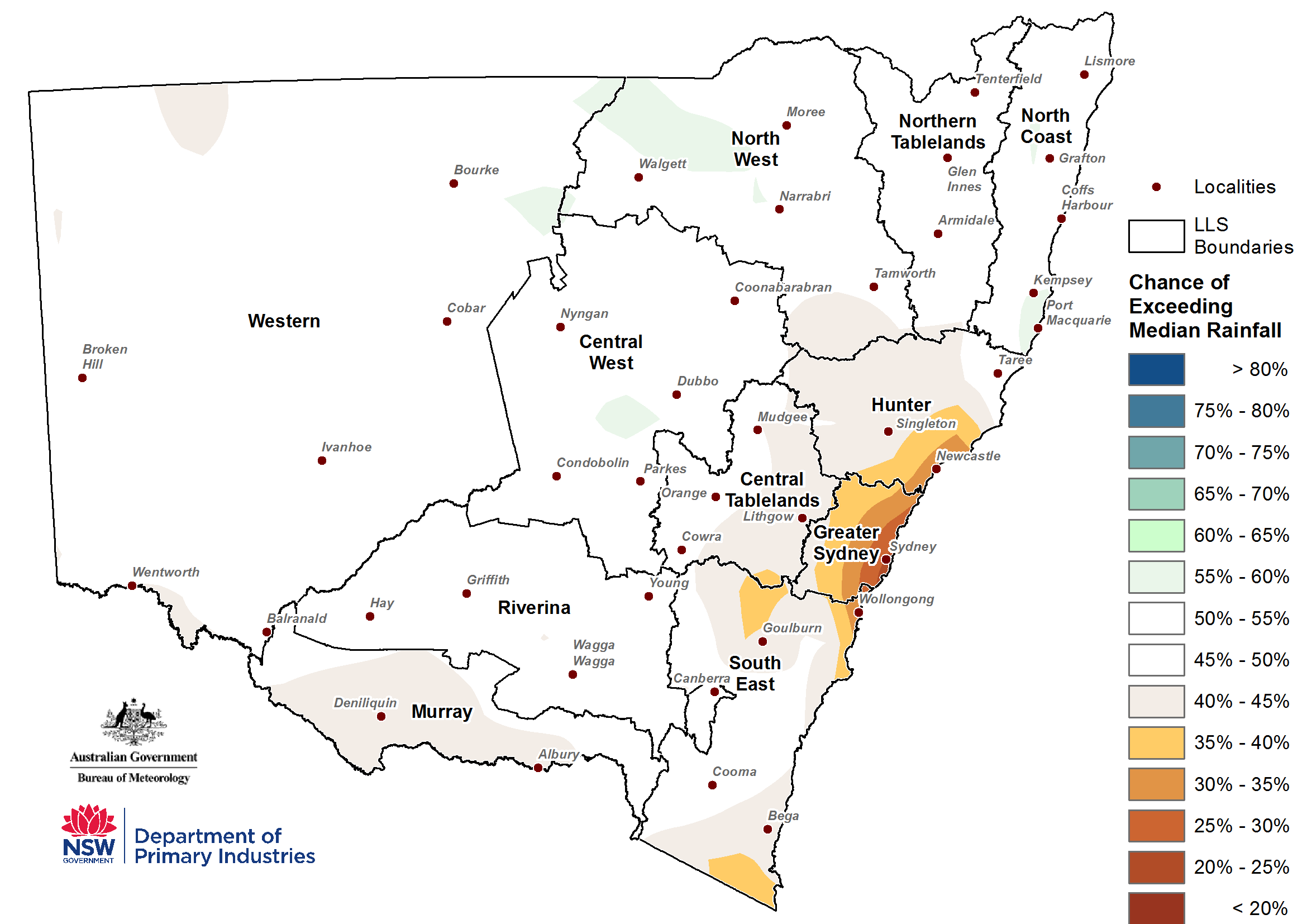
The temperature outlook for April to June (Figures 28 & 29) indicates that there is a very high chance (80%) of warmer than average daytime and overnight temperatures for eastern NSW including all slopes and tableland regions extending east to the coast. Other areas to the west of the slopes are currently indicated to have a 60-70% chance of receiving warmer than average daytime temperatures. There is a high chance (80%) of higher than average overnight temperature forecast across the north eastern half and coastal regions of the state and extending into the southern alpine region. Overnight temperatures are also forecast to be warmer in the southwestern portion of the state, with the probability of warmer than average overnight temperatures ranging between 60-70%.
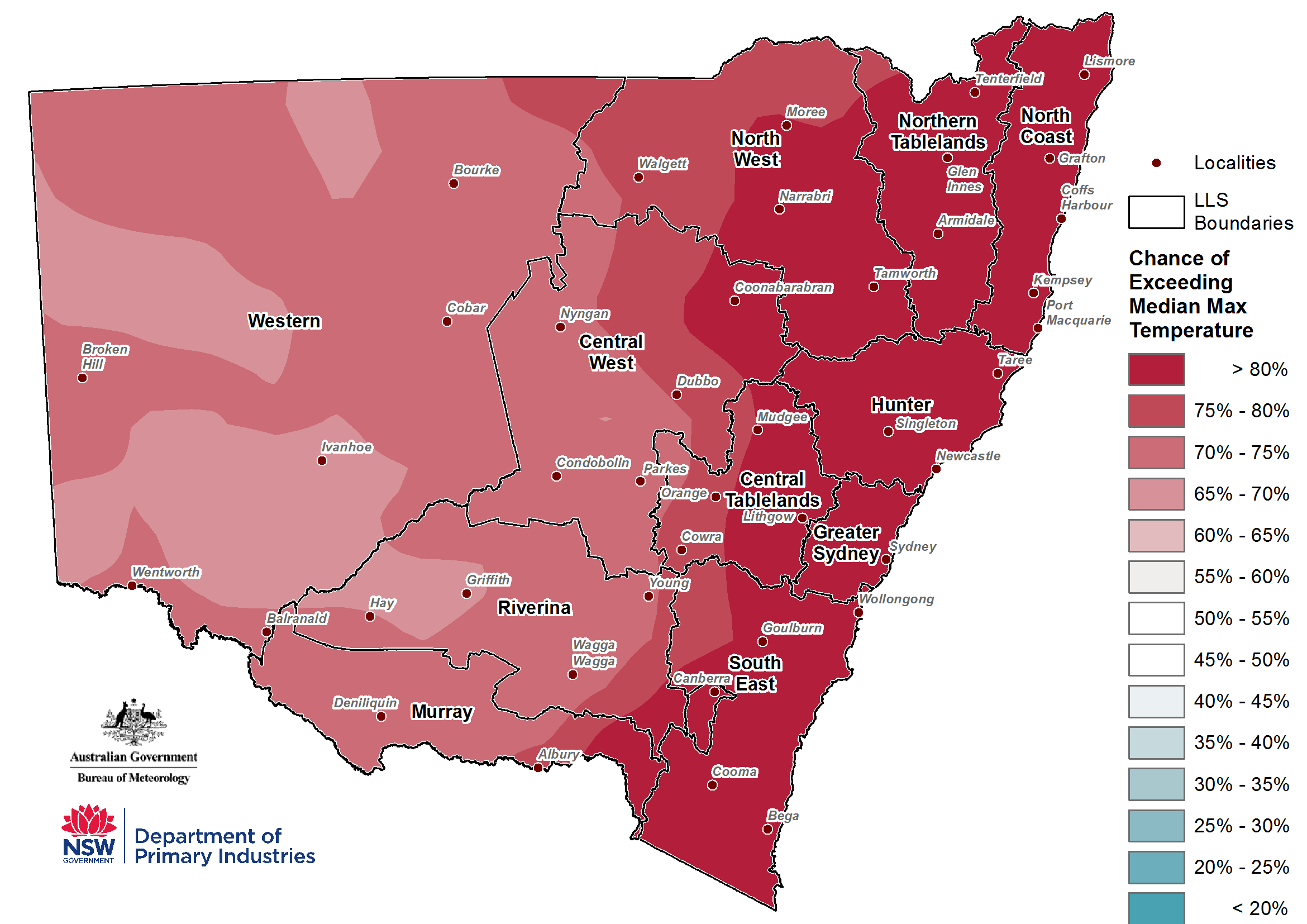
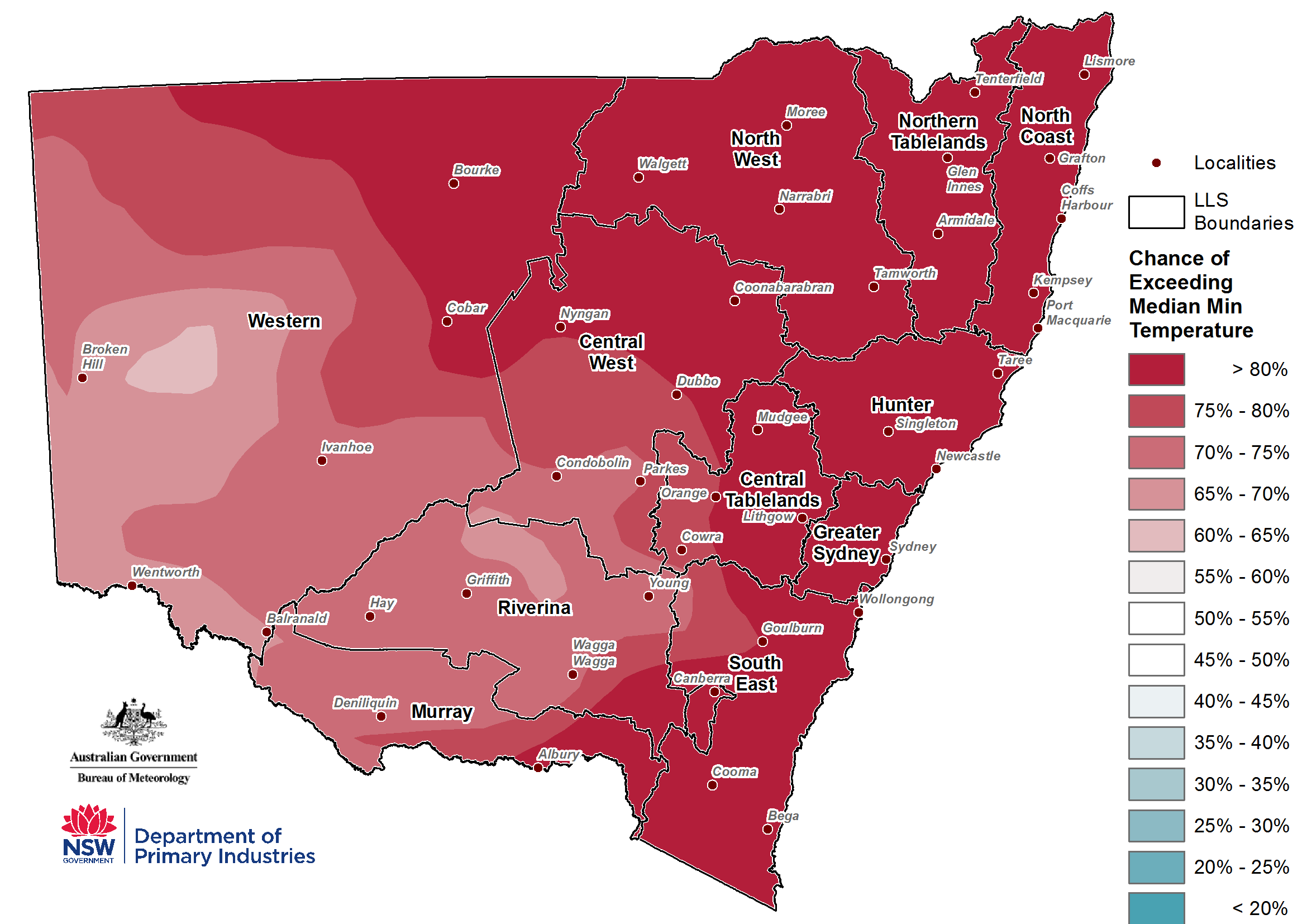
Climate drivers
ENSO
The Bureau of Meteorology’s ENSO assessment was released on 2 April 2019. The ENSO outlook is currently at El Niño Alert, with a 70% chance of an El Niño developing in 2019.
Tropical Pacific sea surface temperatures have remained close to El Niño thresholds for the past five weeks. The atmosphere has responded to the surface warmth at times, but is yet to show a consistent El Niño-like response. For example, trade winds have varied between weaker-than-average and average strength. Most international climate models predict tropical Pacific Ocean sea surface temperatures will remain at El Niño levels at least to mid-year.
Note that ENSO predictions made at this time of year have a lower skill level and therefore less accuracy than those made in winter or spring and should be used with some caution.
Southern Oscillation Index and other indicators
The 30-day Southern Oscillation Index (SOI) has been steady over the past two weeks, remaining close to the El Niño threshold value. The SOI value for the 30 days to 31 March was −7.4. The 90-day SOI value remains within neutral territory at −6.5, but has generally been only a little below the threshold value over the past fortnight. Sustained negative values of the SOI below −7 typically indicate El Niño while sustained positive values above +7 typically indicate La Niña. Values between +7 and −7 generally indicate neutral conditions.
Since early December, cloud levels near the Date Line have tended to be above average. Values during February were more strongly positive, associated with monsoon and tropical cyclone activity near the Date Line. In March these values weakened, however remained at positive levels. Equatorial cloudiness near the Date Line are typically positive and increase during an El Niño event.
Trade winds for the 5 days ending 31 March were stronger than average in the east, but were weaker than average in the western tropical Pacific. The Madden-Julian Oscillation (MJO) has been weak since mid-March, and is not currently exerting a strong influence on trade winds. During El Niño there is a sustained weakening, or even reversal, of the trade winds across much of the tropical Pacific. Conversely, during La Niña, there is a sustained strengthening of the trade winds.
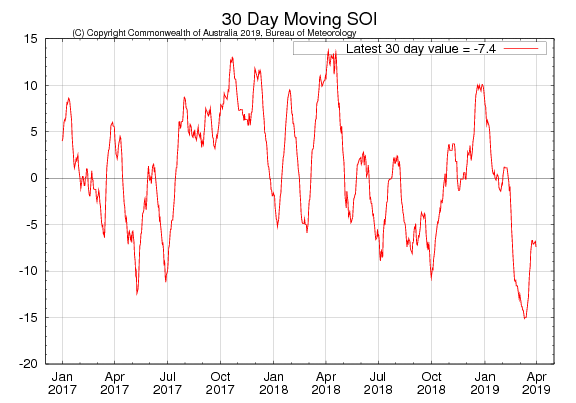
Sea surface temperatures
Monthly sea surface temperature anomalies (SST) for March (Figure 31) were warmer than average across the tropical Pacific Ocean. The latest values for the three key NINO indices in the Tropical Pacific (for the week ending 31 March 2019) are: NINO3 +0.7°C, NINO3.4 +0.8°C and NINO4 +0.7°C. There is also anomalously warm sea surface temperatures affecting the south Pacific, extending from the south eastern Australian coastline to New Zealand.
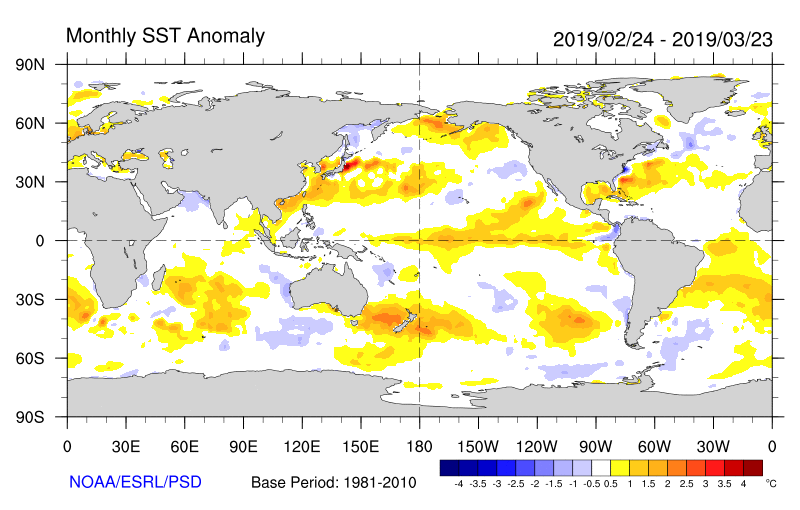
Sea Subsurface Temperatures
As of 28 March 2019, the four-month sequence of sub-surface temperature anomalies shows warm anomalies across most of the top 125m of the equatorial Pacific sub-surface, with the exception of both the far western and far eastern ends of the basin. A small volume of cool anomalies persist between roughly 125 m and 200 m depth around the Date Line, between 170°W and 150°E. Warm anomalies have been decreasing from late 2018 into the first quarter on 2019.
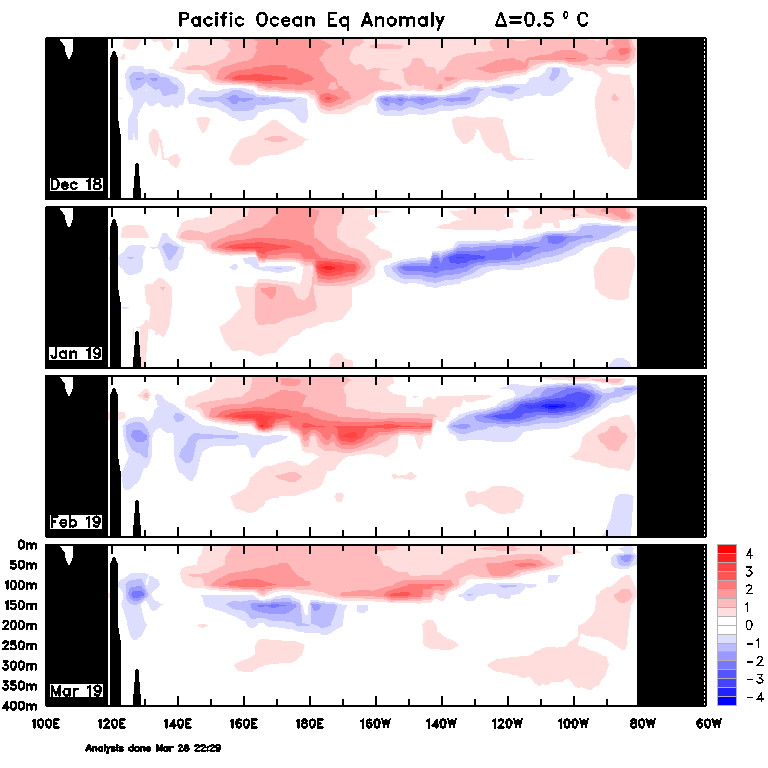
Indian Ocean
The Indian Ocean Dipole (IOD) is currently neutral. The latest weekly index value to 31 March was −0.32 °C.
The IOD typically has little influence on Australian climate from December to April due to the movement of the monsoon trough in the Indian Ocean. When the monsoon trough shifts southwards into the southern hemisphere during this period, it changes the broadscale wind patterns, meaning that the IOD pattern is unable to form. Model outlooks suggest the IOD is likely to remain neutral for the remainder of the autumn period, with the possibility of a positive IOD in winter. A positive IOD typically means drier than average conditions for southern and central Australia during winter-spring.
How does it work?
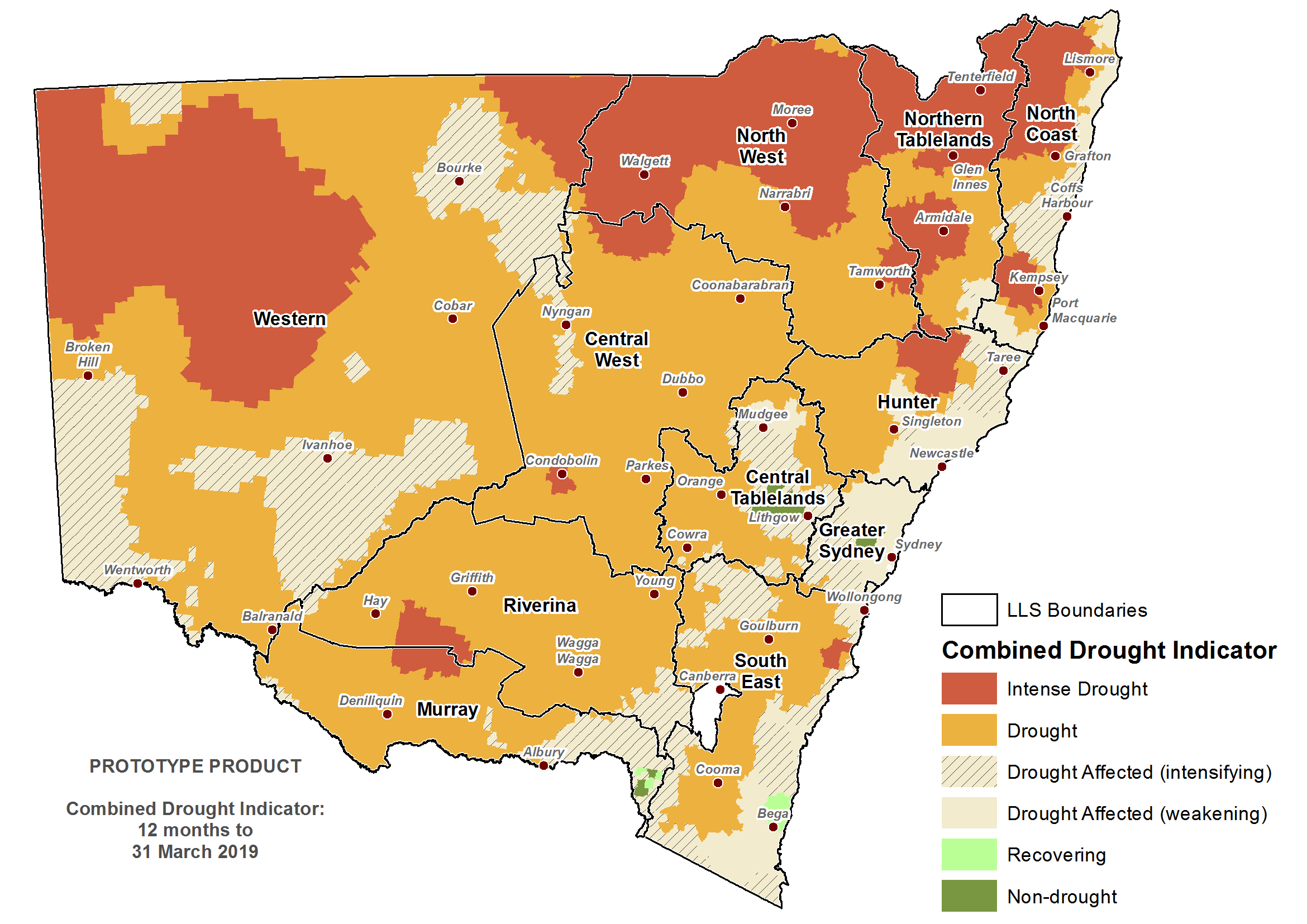
Much of the information in the Seasonal Conditions Report is sourced from the NSW DPI Enhanced Drought Information System (EDIS) ™. The EDIS system is currently available in prototype form and is subject to an intensive ground truthing process. For more information, visit the interactive website via Drought Hub.
EDIS is an ongoing project aimed at improving the quality and timeliness of efforts to monitor conditions across the state. Key features of the system are:
- It tracks drought by using four indicators; rainfall, soil water, plant growth, as well as tracing rainfall trends. Agronomic conditions have equal value to rainfall recorded at meteorological stations.
- The Combined Drought Indicator (CDI) brings this information together, and has been designed to characterise developing drought conditions. The key purpose for building the CDI was as a drought early warning system.
- The rainfall, soil moisture and plant growth indicators in EDIS account for conditions over a 12 month window. This provides a compromise between a highly sensitive indicator (e.g. six months) and a less sensitive indicator (e.g. 24 months).
- Climate and remote sensing data drive the information system at a high resolution, but the CDI is reported at a Parish level.
- Because of its configuration and purpose, there will be differences to the indicator used in the National Drought Monitoring Framework (the Australian Rainfall Deficiency Analyser) which relies on rainfall alone.
- The CDI has three drought categories that characterise NSW according to drought intensity as well as the main drivers of a drought event (meteorological, hydrological and agronomic). DPI considers areas Drought Affected to be experiencing a drought event.
- The Drought Affected category encompasses a wide range of conditions from the very early stages of drought entry through to a drought event becoming intense. This enables the drought monitoring system to detect a drought event early. It is also possible to stay in the Drought Affected category for some period of time.
The way in which the indicators are combined to form the CDI is described in Table 2 below.
Table 2: Description of the Combined Drought Indicator framework
CDI Phase | Technical definition | Description - typical field conditions |
|---|---|---|
Intense Drought | All three indicators (rainfall, soil water, plant growth) are below the 5th percentile | Ground cover is very low, soil moisture stores are exhausted and rainfall has been minimal over the past 6-12 months. |
Drought | At least one indicator is below the 5th percentile | Conditions may be very dry, or agronomic production is tight (low soil moisture or plant growth). It is possible to be in Drought when there has been some modest growth, or a few falls of rain. |
Drought Affected (intensifying) | At least one indicator is below the 30th percentile and the rainfall trend is negative over the past 90 days. | Conditions are deteriorating; production is beginning to get tighter. Ground cover may be modest, but growth is moderate to low for the time of year. When indicators are close to the Drought threshold drought conditions are severe. |
Drought Affected (weakening) | At least one indicator is below the 30th percentile and the rainfall trend is positive over the past 90 days. | Production conditions are getting tighter, but there have been some falls of rain over the past month. It is rare to enter the Recovering phase from the Non-Drought category; Usually there is a quick (1-2 week) transition into Drought Affected or Drought. When indicators are close to the Drought threshold drought conditions are severe. |
Recovering | All indicators are below the 50th percentile but above the 30th percentile | Production is occurring but would be considered ‘below average’. Full production recovery may not have occurred if this area has experienced drought conditions over the past six months. |
Non-drought | At least one indicator is above the 50th percentile. | Production is not limited by climatic conditions. |
The NSW State Seasonal Update is provided each month by the NSW DPI Climate Unit, which is part of the Livestock Systems Branch in DPI Agriculture.
Information used in this report was primarily sourced from the Australian Bureau of Meteorology, the US National Oceanic and Atmospheric Administration, the International Research Institute for Climate and Society (Columbia University), Geoscience Australia’s Digital Earth Australia Program, and NSW Department of Primary Industries.
Maps in this document contain data which is © Spatial Services – NSW Department of Finance, Services and Innovation (2018), Panorama Avenue, Bathurst 2795 and data which is © Commonwealth of Australia 2018, Australian Bureau of Meteorology, Melbourne. All rights reserved.
The seasonal outlooks presented in this report are obtained from the Australian Bureau of Meteorology and other sources (including World Meteorological Organisation Global Producing Centres). These outlooks are general statements about the likelihood (chance) of (for example) exceeding the median rainfall or minimum or maximum temperatures. Such probability outlooks should not be used as categorical or definitive forecasts, but should be regarded as tools to assist in risk management and decision making. Changes in seasonal outlooks may have occurred since this report was released.
All climate and remote sensing input data is supplied to the Enhanced Drought Information System ™ under the Australian Creative Commons Licence (CCY 4.0) and is made available by the Terrestrial Ecosystem Research Network.
© State of New South Wales through the Department of Industry, Skills and Regional Development, 2019. You may copy, distribute and otherwise freely deal with this publication for any purpose, provided that you attribute the NSW Department of Primary Industries as the owner.
Disclaimer: The information contained in this publication is based on knowledge and understanding at the time of writing (March 2019). However, because of advances in knowledge, users are reminded of the need to ensure that information upon which they rely is up to date and to check currency of the information with the appropriate officer of the Department of Primary Industries or the user’s independent adviser.
Published by the NSW Department of Primary Industries. ISSN 2202-1795 (Online). Volume 7 Issue 3

